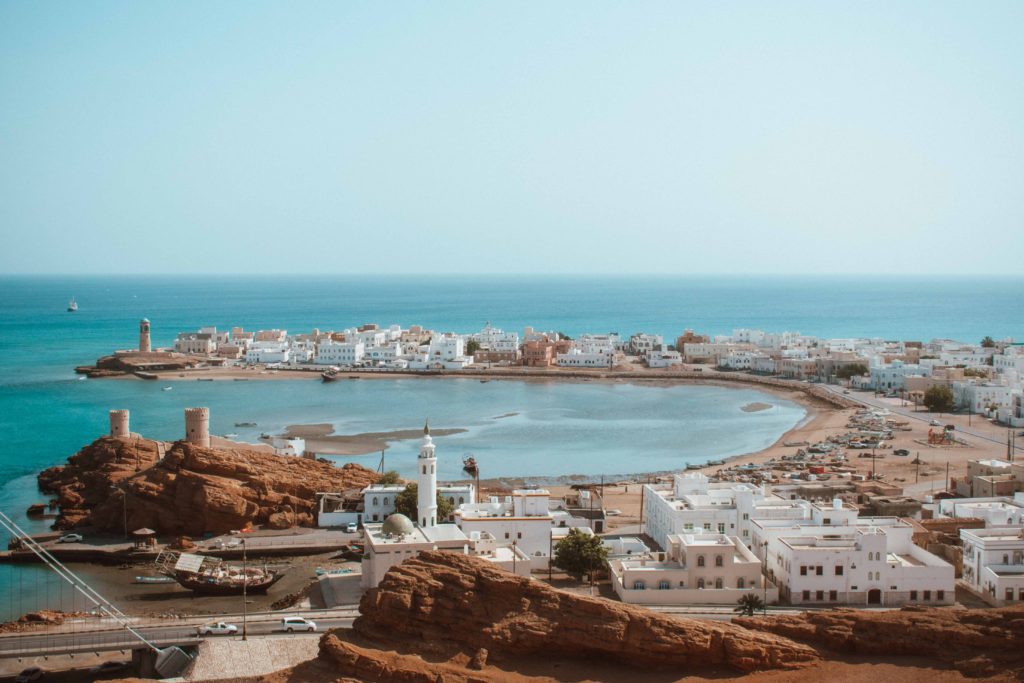
Sometimes referred to as Oman’s Route 66, the coastal route between Muscat and Sur offers a selection of Oman’s best sights, packed into a 200km stretch of road. For almost all of the route you have the blue-green Arabian Gulf on one side, and the vast Eastern Hajar Mountains on the other.
Sur was once the centre of Oman’s colossal maritime power, at a time that the Omani empire extended all the way down the east coast of Africa to Mozambique and across the Gulf into Iran. It is also one of the two rumoured homes of the mythical sailor Sindbad – the second being the town of Sohar just north of Muscat.
Many of the sights along this route are some of the best known on the typical Oman road trip itinerary – and for good reason – and they offer an interesting add on if you are planning a visit to the deserts of Wahiba Sands.
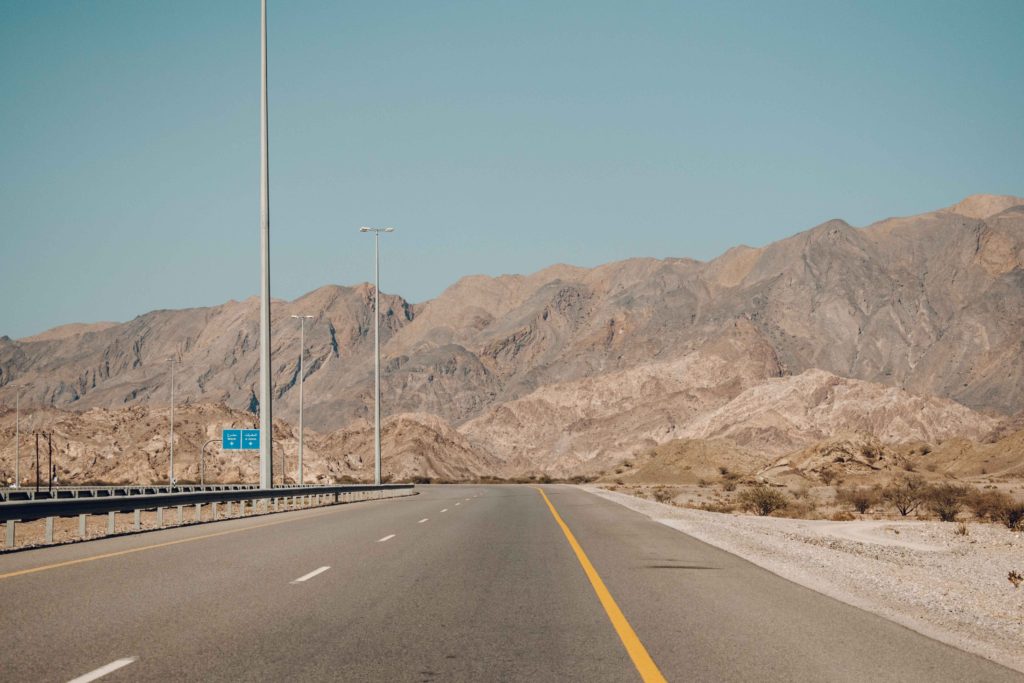
WHAT TO SEE AND DO
QURIYAT
Around 45 minutes south of Muscat, the small fishing town of Quriyat is a nice place to stretch your legs if you are planning to head further down the coast. The town was originally an important port, but was sacked by the Portuguese in the 16thC.
The town itself is pretty small, although there is a fort to visit (500 baisa; 8.30am-2.30pm) and a stretch of sandy beach. The main area of interest is the khawar or creek, which is now one of the main salt producing areas in the country. Omani salt is highly prized across the Gulf. The creek outside Quriayt is owned by local families, with the whole area divided up into small squares that produce sea salt.
The salt farms are not a tourist attraction, and are residents’ livelihoods. Therefore if you plan to visit please keep a respectful distance unless invited to walk between the squares and always ask before taking any photographs.
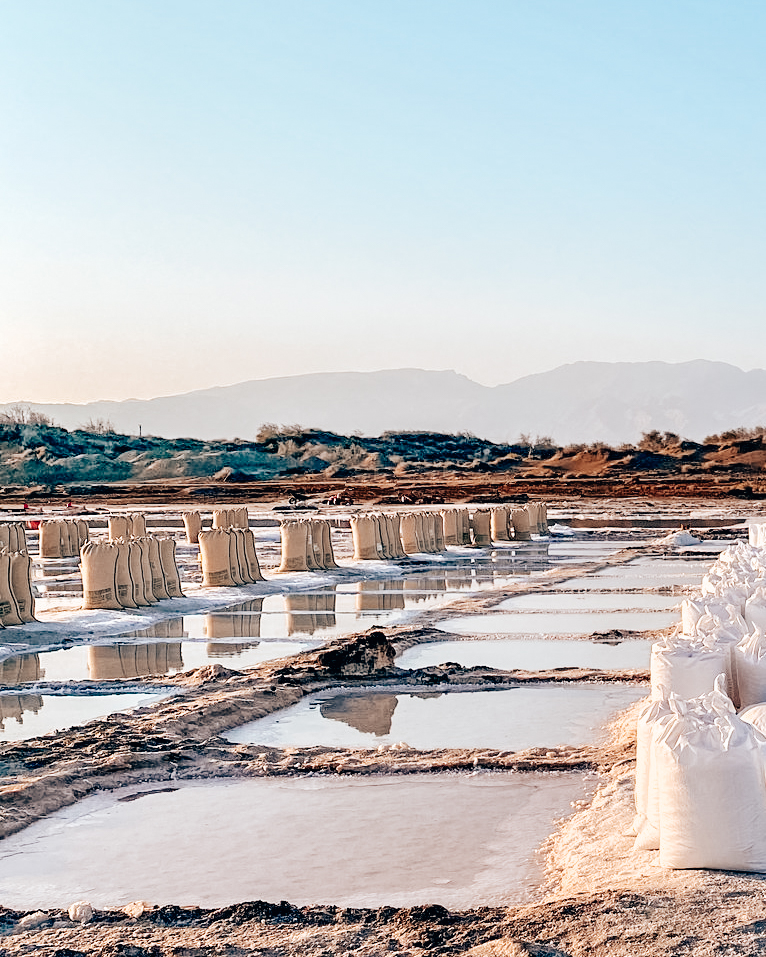
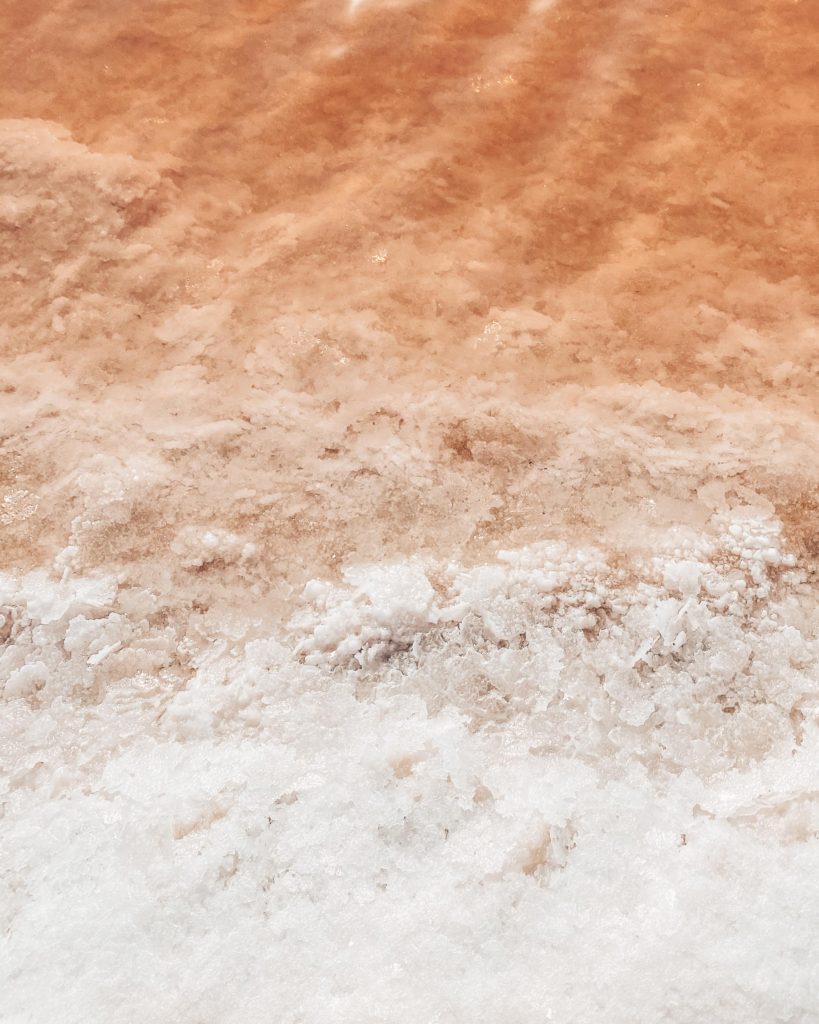
WADI ARBAEEN
This is possibly my favourite wadi so far in Oman! A wadi is a dry riverbed that usually only contains water at certain times of the year, when there is heavy rainfall, forming pools in which to swim.
It is offers more adventurous trekking than others, and the pools themselves are beautiful. It is also vast meaning there is plenty to explore no matter how many times you visit. You could easily spend a whole day here exploring and swimming, and find a wonderful camp site nearby.
A 4WD is needed to reach Wadi Arbaeen – whether you drive to the village along the unpaved track off the main road, or if you drive all the way up through the wadi bed.
The turning towards Wadi Arbaeen is sign posted from the Hwy 17. Once you turn off, keep going until you hit the dirt road. This will take you to a junction, at which you should take the signposted route. Keep going past the small village supermarket on your left – just before this you will see a road leading off to the left, and down into the wadi bed. This is the wadi road which starts in Dhabab (fully off road). Keep driving until you get to a bright red and somewhat alarming “danger” sign – take the hint and park up there. The first pool you come to is accessible for those with a limited ability to walk too far, or who are not keen on scrambling over boulders.
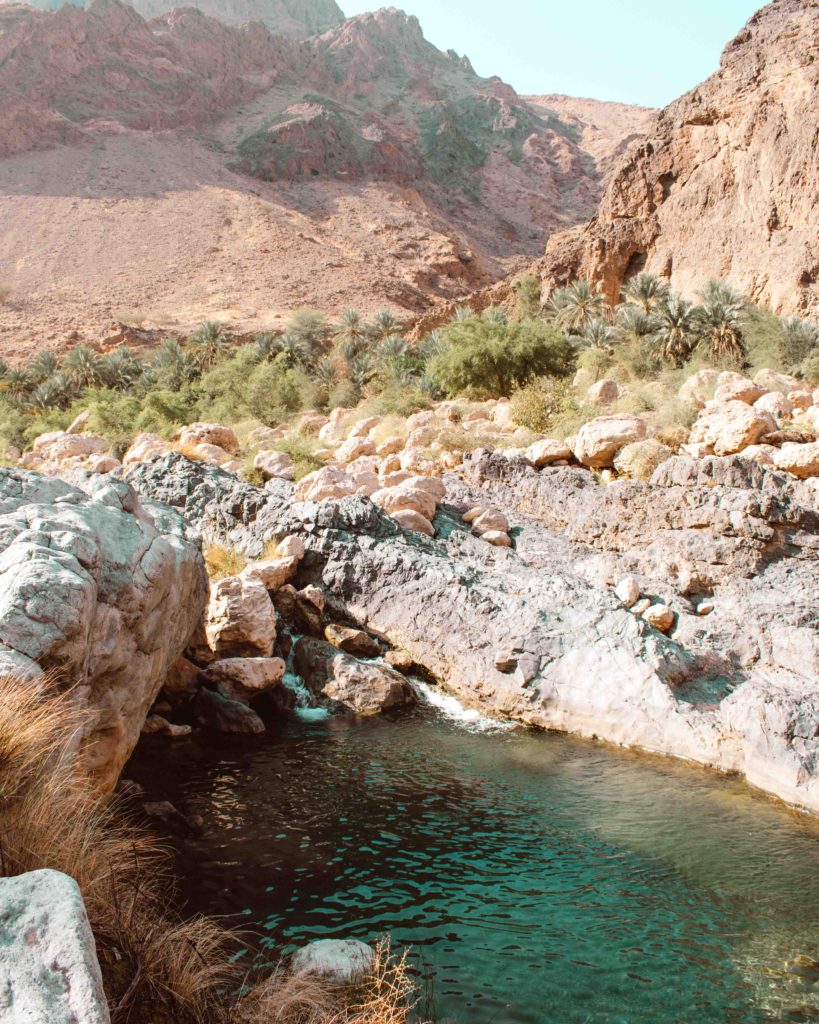
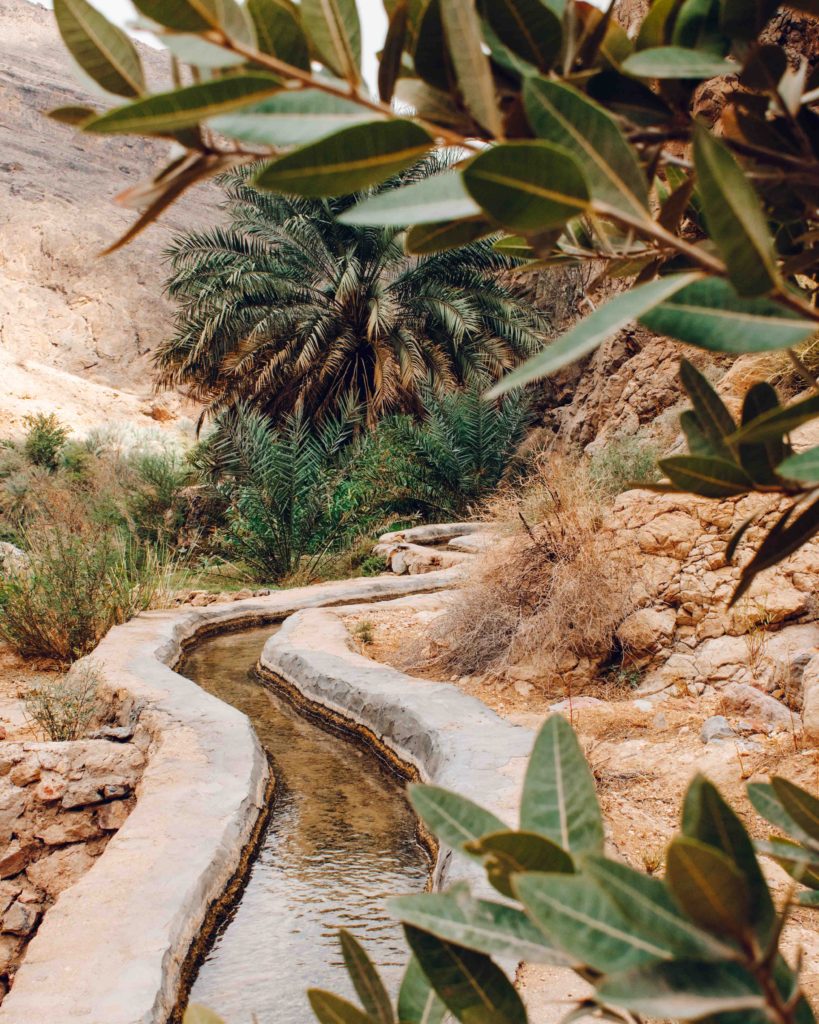
There are two options once you get into the wadi. You can either cross the first pool and head up to the right. A few hundred metres in you will see a traditional Omani irrigation system – the falaj – which offers an easier route to follow and walk along. Don’t walk in the water – this is still a working water source for the village. After about one and a half hours you will reach a huge waterfall and a series of pools you can swim in.
If you take the left hand route at the first pool, it will take you up to pools of clear water, that become ever more secluded the further you walk.
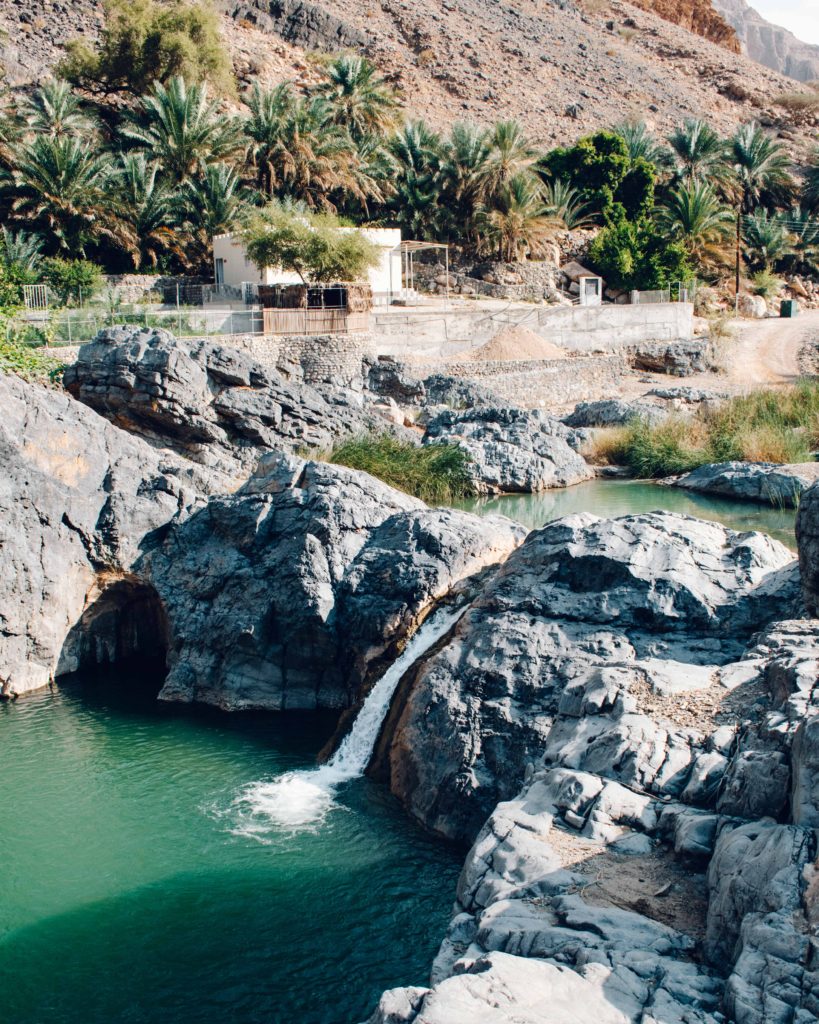
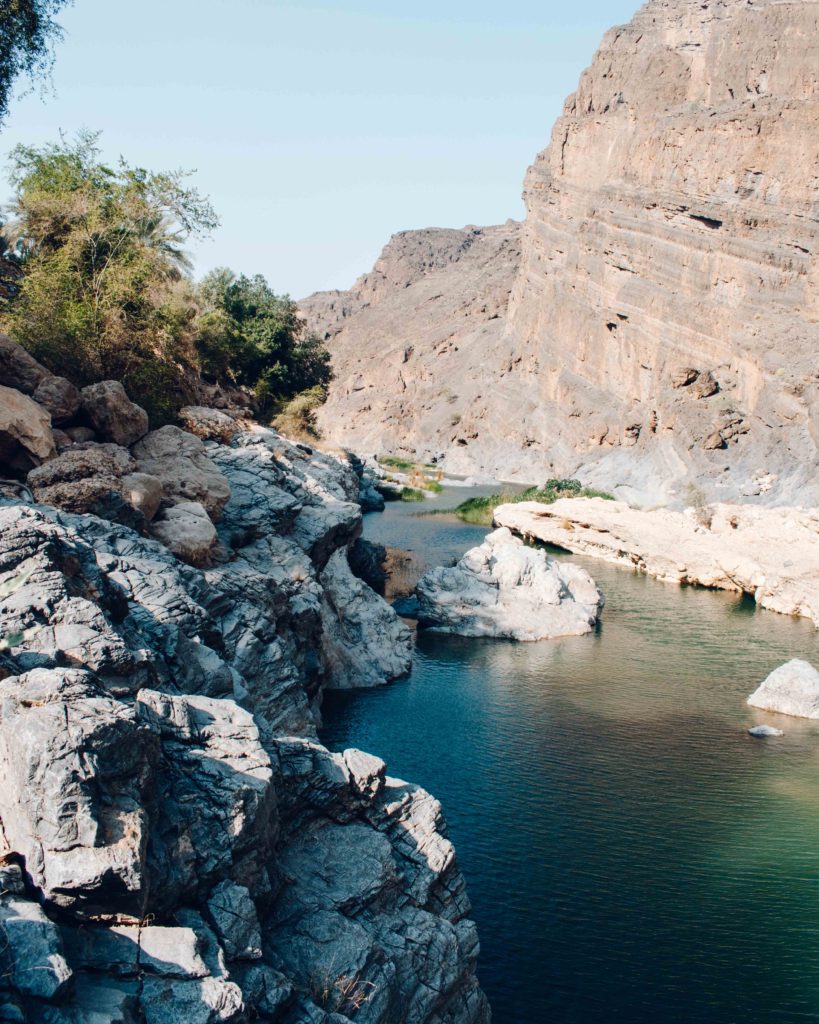
BIMMAH SINKHOLE
This amazing sinkhole is not dissimilar to the cenotes of Mexico, and the water is a glorious shade of blue-green. Geologists believe it was created when a limestone cave collapsed, but local tradition is that a piece of the moon fell from the sky and carved out the giant hole.
The view from the top is gorgeous, but on a hot day the water looks irresistible. In places the water is 20m deep, so make sure you are a strong swimmer if you want to swim across. You should also expect a foot massage from the little fish that live in the sinkhole!
Bimmah Sinkhole is open from 8am-8pm, and free to enter. I recommend getting there as soon as it opens if you want to avoid the crowds. It is about 90 minutes from Muscat, and doable in a day trip. There are changing rooms, toilets, a small children’s play park and a number of picnic tables on site. The sinkhole is very popular with local families, so dress should be modest. There is a sign at the entrance asking both men and women to cover shoulders and knees. During a quieter weekday, you may be able to swim in a one-piece swimming costume, but take a t-shirt to cover up whilst swimming if other families are around.
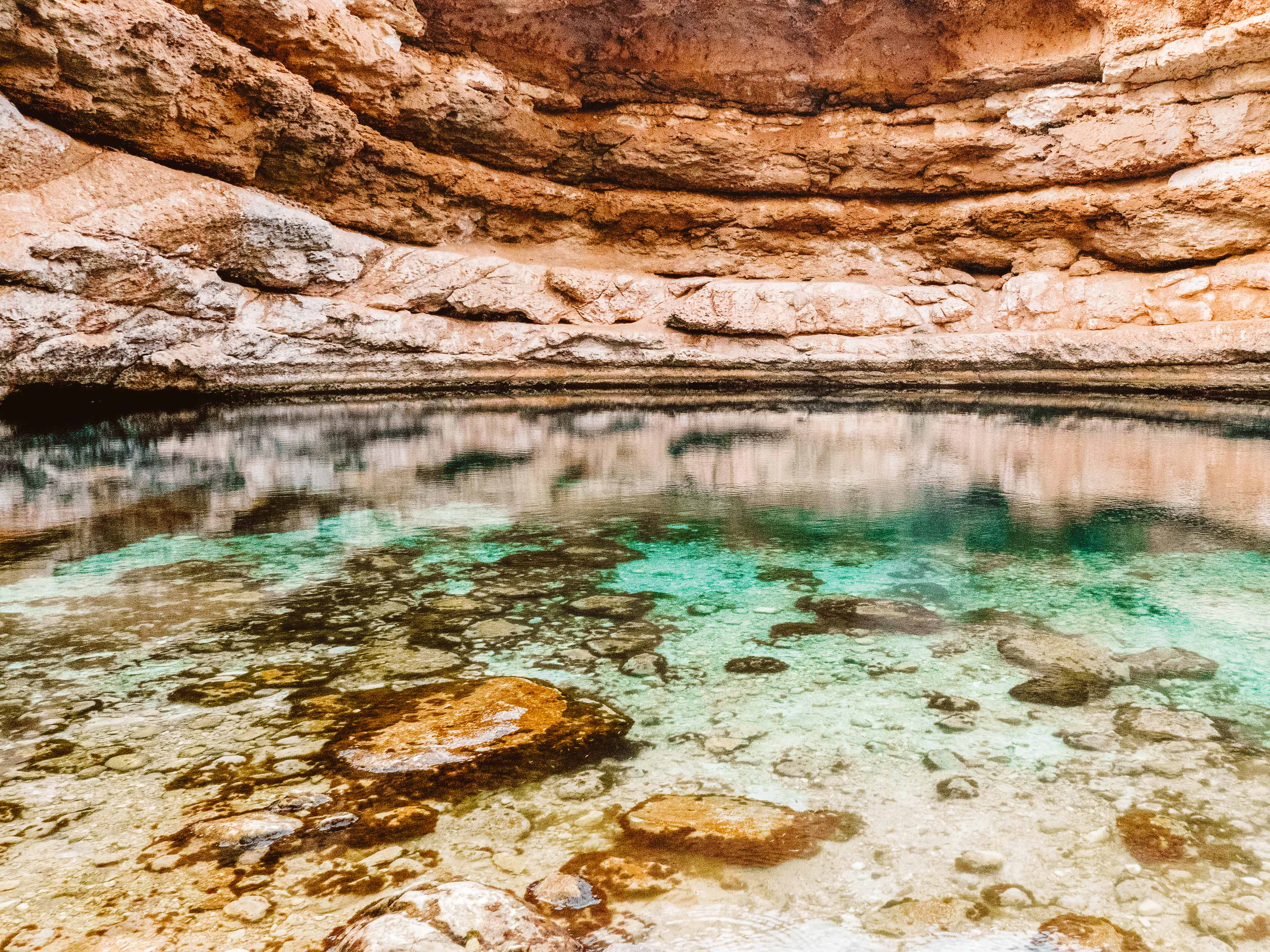
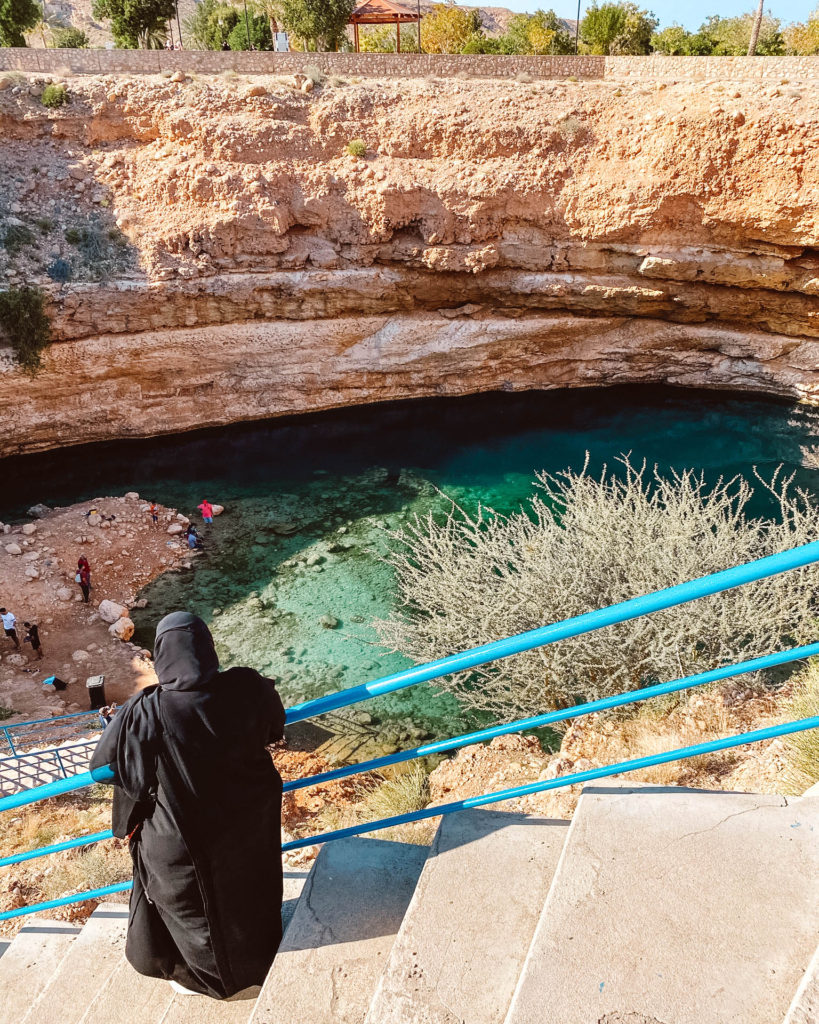

WADI SHAB
Around 20 minutes on from the sinkhole is Wadi Shab, one of the most well known wadis in Oman. Once you have parked up, you will need to pay one of the local boatmen to take you the short distance across to the other side of the river. The return trip costs 1 OMR.
Follow the path through the gorge for around 45 minutes, through towering cliffs to the main pools. The walk is not difficult but does require some clambering over large boulders.
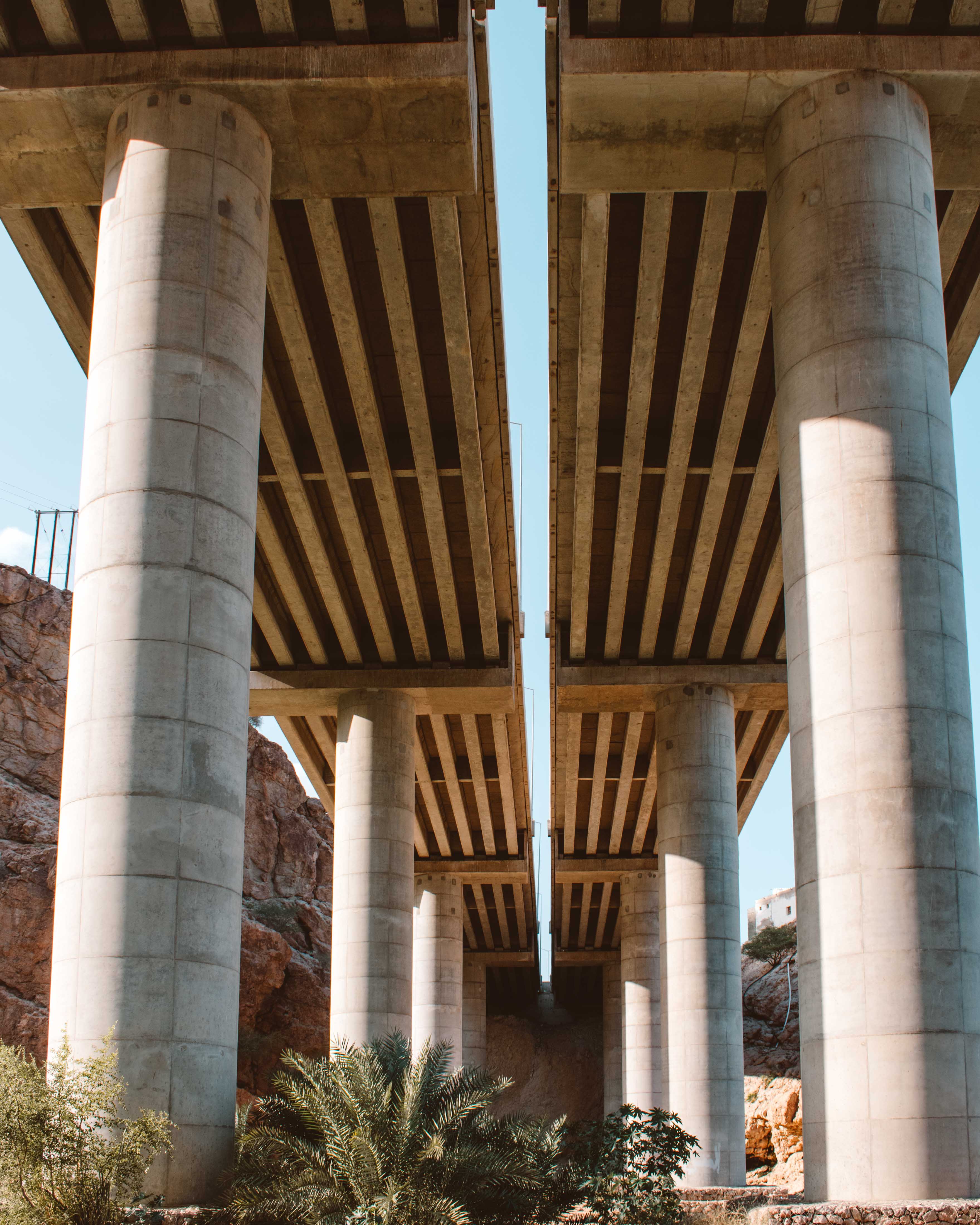
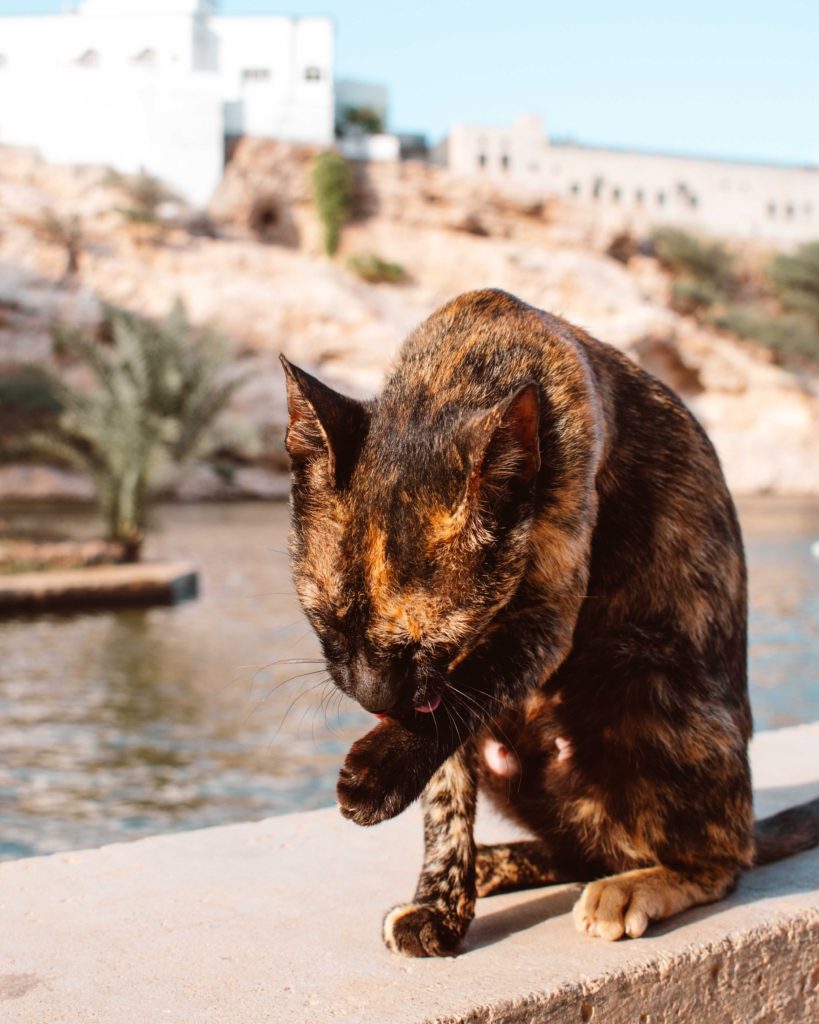
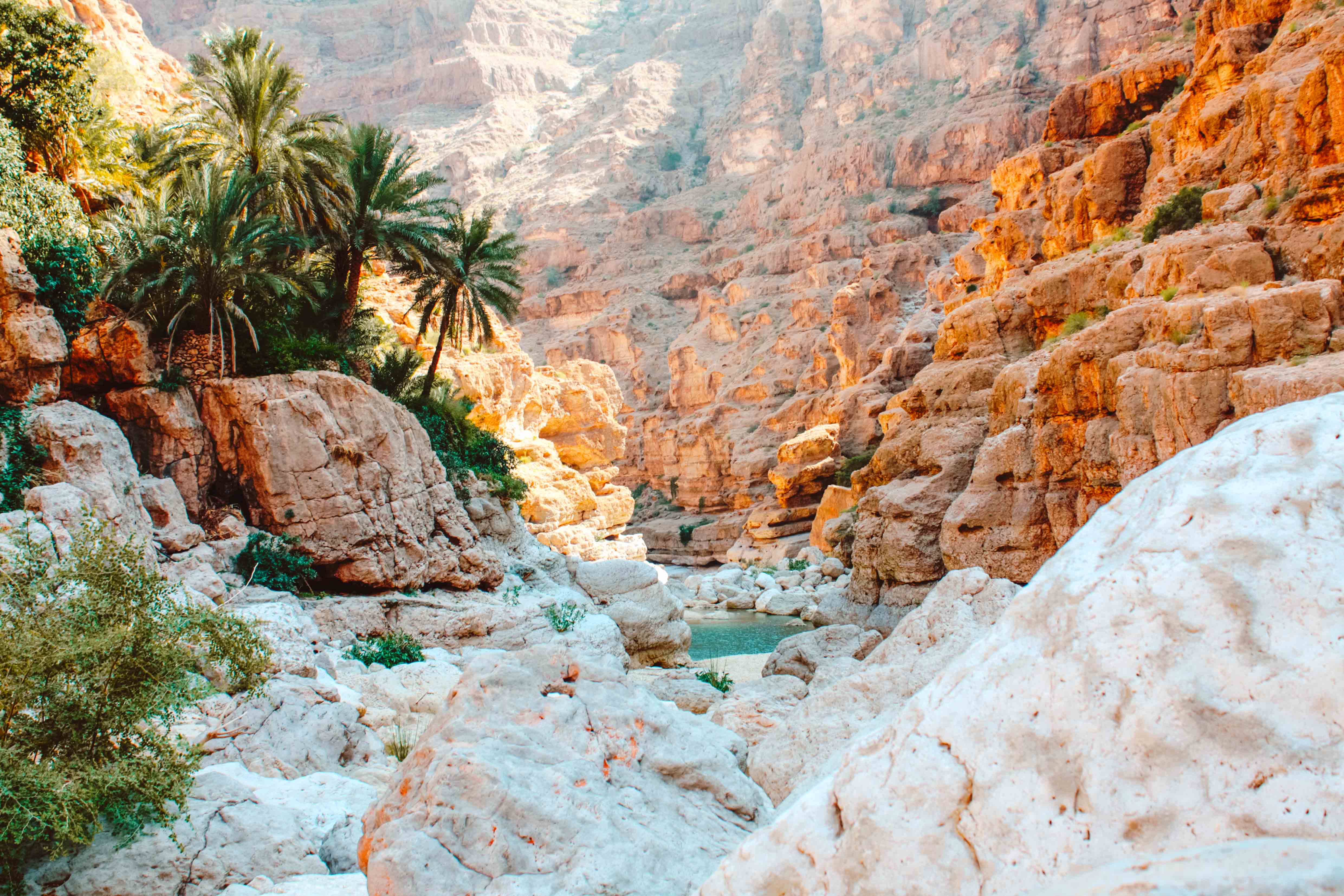
The swimming area is comprised of three interconnected pools of spectacularly blue water. Remember to pack water shoes or trainers, as when the water is low you may need to walk through drier rocky ground to get between the pools. The first two pools are mostly shallow enough to stand in, but the third gets fairly deep.
Once you swim to the end of the third pool, you will see a small crack in the rock. It is only just enough to fit your head between the rocks (although wider under the water, allowing you to swim), but if you are a confident swimmer, you can squeeze through into a fourth pool with a waterfall. Be aware that you cannot stand inside the cave and there aren’t many places to hang on.
Weekends get incredibly busy, so try to visit on a weekday if possible. Boats start running at around 8am and stop at 5pm, and there are free bathrooms at the Wadi Shab parking area.
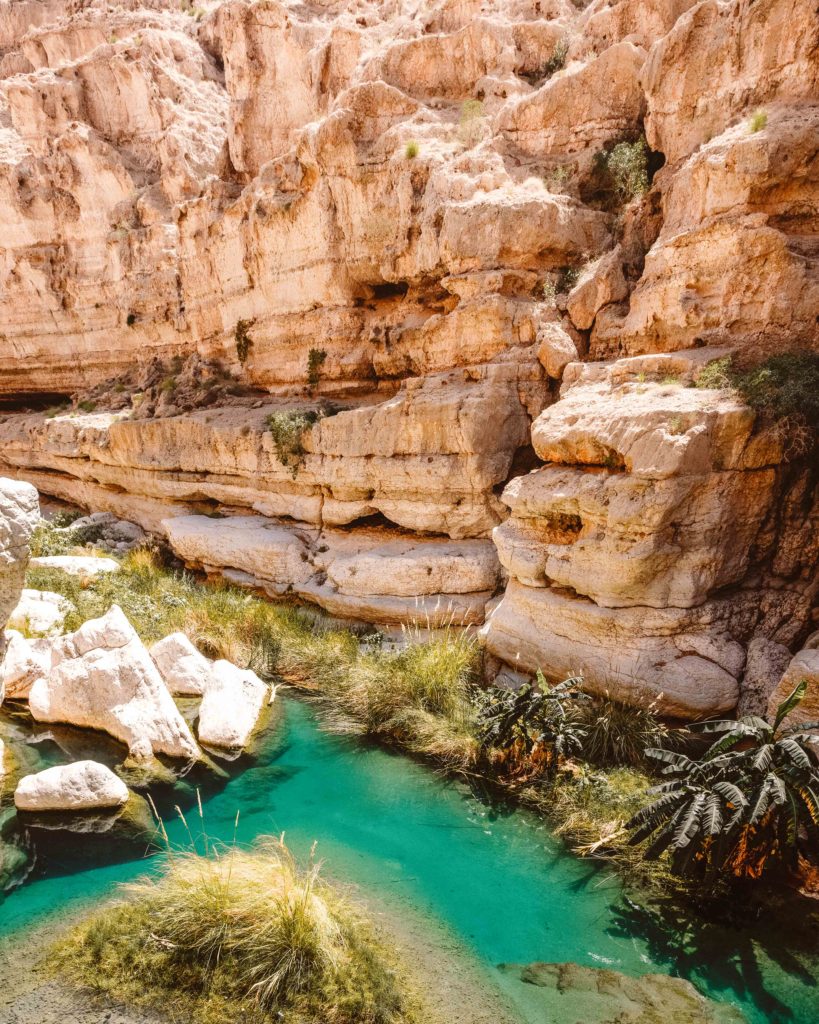
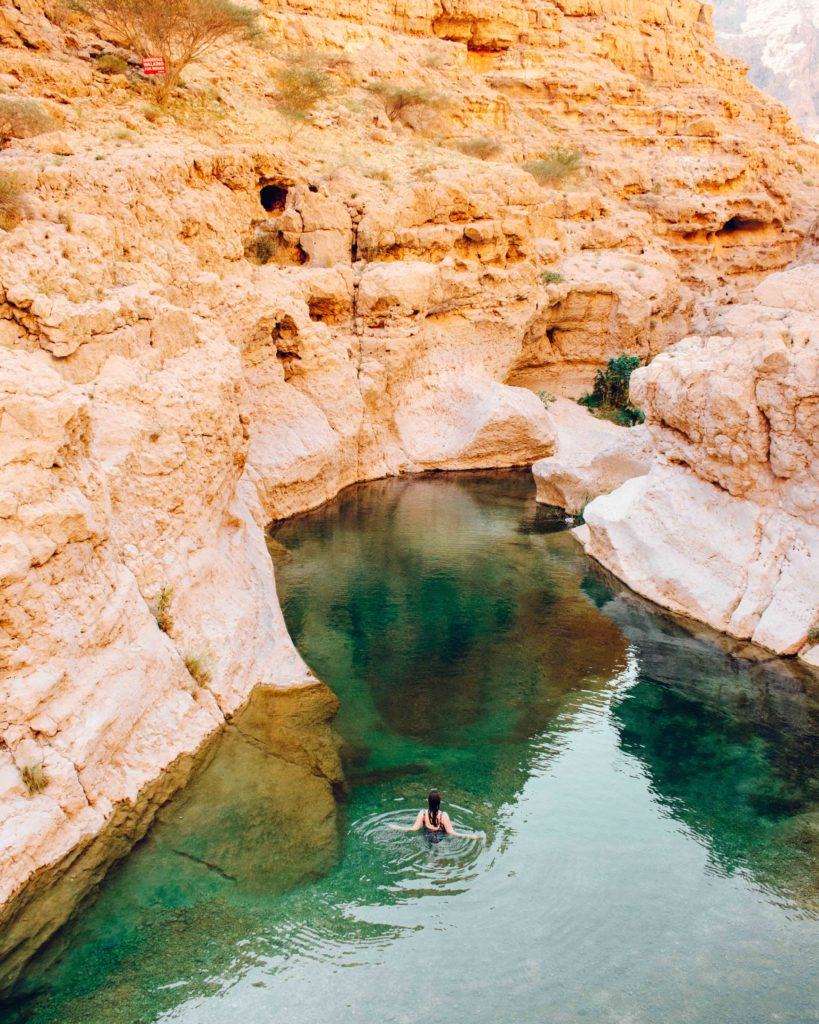
WADI TIWI
Much greener than many other wadis, beautiful Wadi Tiwi – just slightly further down the coast than Wadi Shab – has a more jungle-like feel, with palm trees and foliage surround the pools.
You need a 4WD to access Wadi Tiwi – it requires off road driving for around half an hour until you get to the outskirts of the village of Mibam to reach the start of the wadi. Once you walk past the houses, you will see a set of steps leading down into the wadi. Following this track for around 2-3 hours brings you to a gorgeous azure pool flanked by palm trees. The path is easy enough to follow, and doesn’t require too much scrambling over boulders. If you are a confident swimmer, from here you can swim around 100m across the pool, to reach to the Mibam waterfall.
Tour companies such as Husaak Adventures can arrange guided trips into the Wadi and abseiling into the pools if you are looking for something more adventurous.
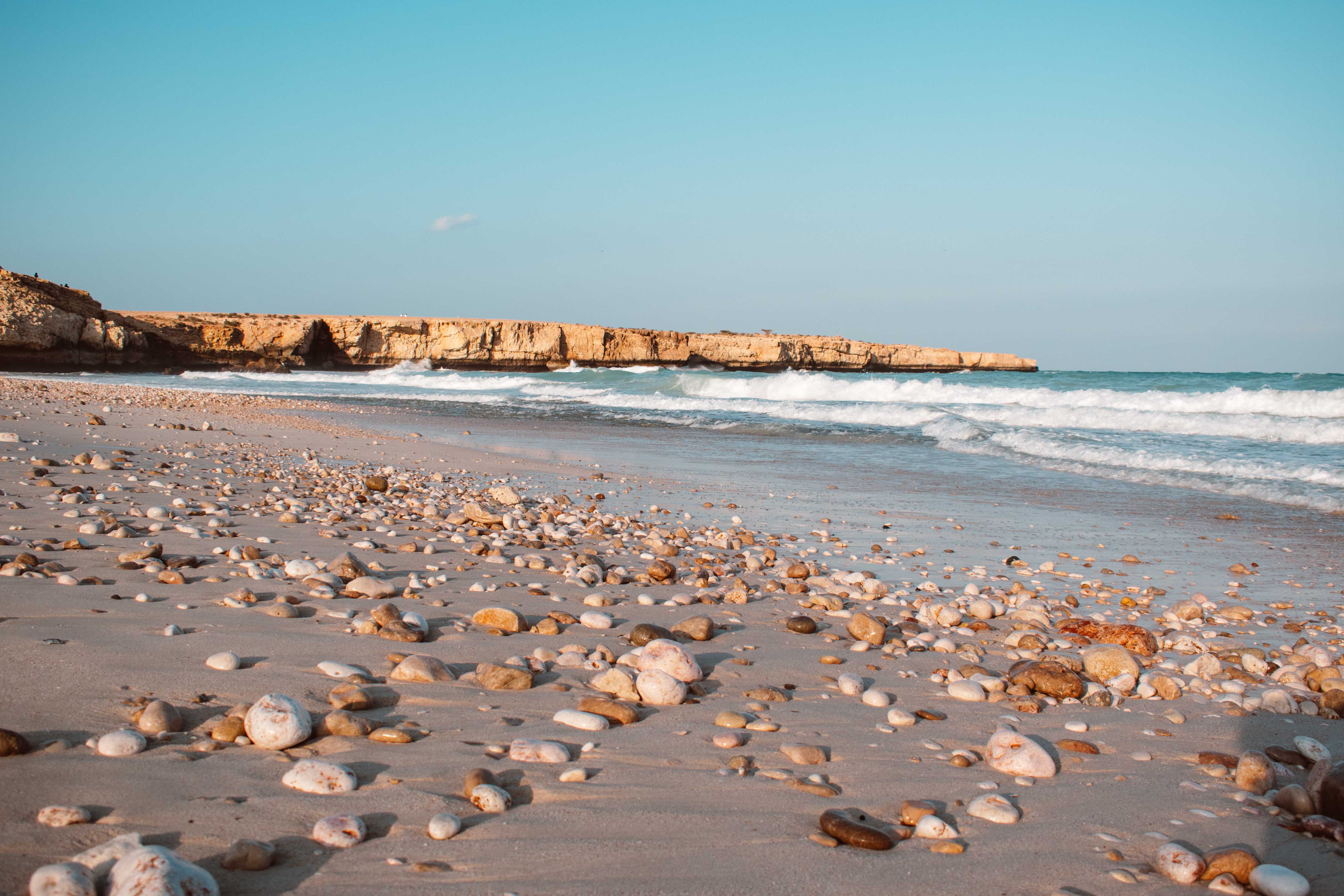
BEACHES
Fins Beach or White Beach – 5km south of the town of Fins, this long stretch of beach has white sands, smooth pebbles and turquoise waters. The cliffs to the north of Fins are covered with blowholes, and driving up you will see huge plumes of spray shooting upwards. It is quite an awe-inspiring sound to sleep alongside!
There are no facilities here, and it can get very busy at weekends as it is popular camping spot for families. You do not need a 4WD to access the cliffs, but of course a more rugged vehicle would allow you to access more camping spots.
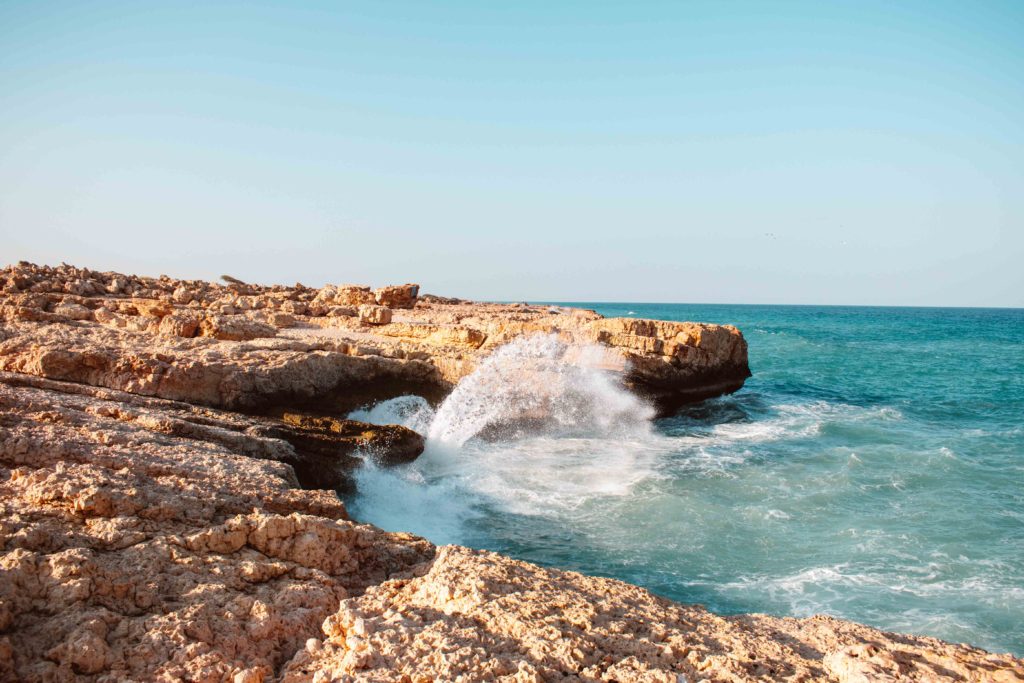
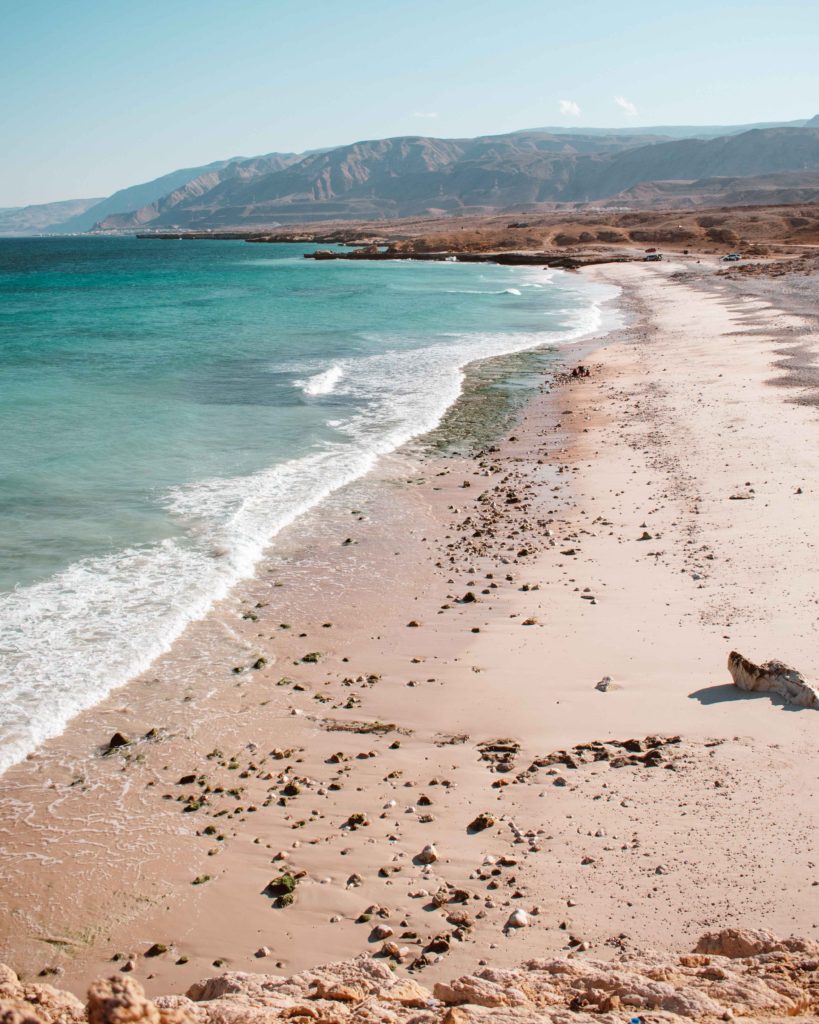
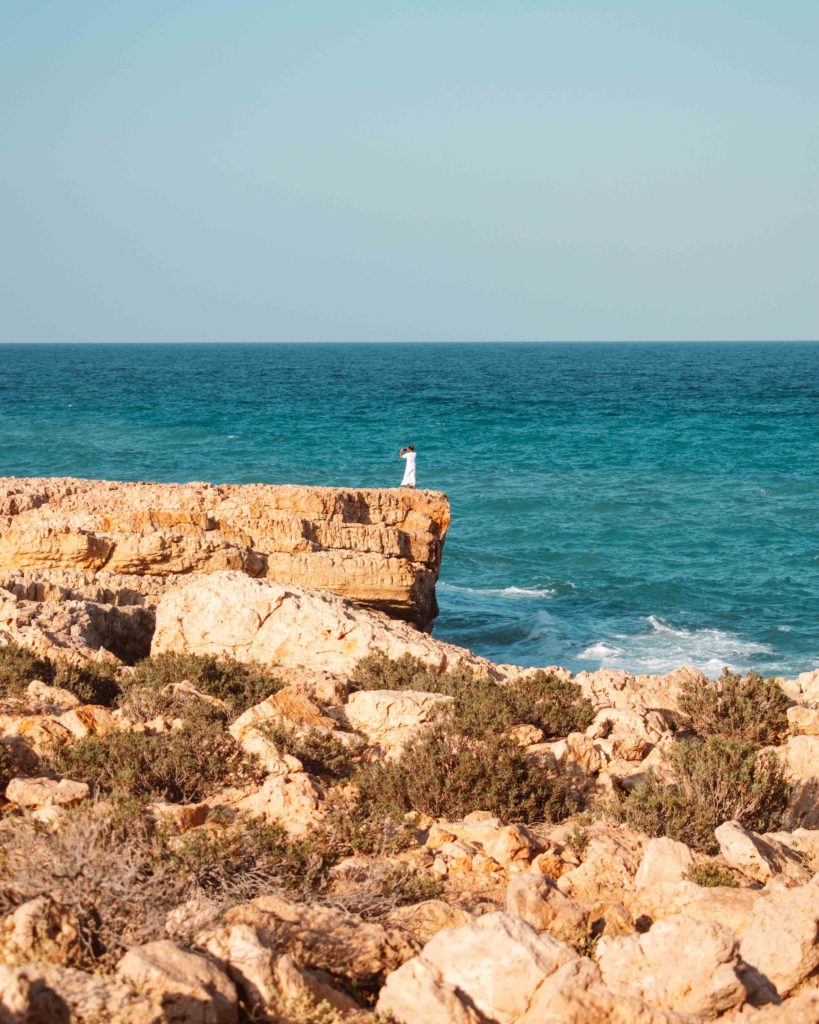
Pebble beaches – the coast south of Fins until you reach the town of Tiwi is peppered with lovely pebble beaches. I actually prefer this stretch of coast to that immediately around White Beach. Often empty whilst Fins is busy, and with less litter, the cliffs and beaches here are great setting for a camp site and BBQ, and you can often spot turtles in the surf from the cliffs above.
ANCIENT CITY OF QALHAT
Qalhat was Oman’s first capital city, and the port was one of ancient Arabia’s most important. An earthquake in the 14thC and the subsequent Portuguese occupation left the city in ruin. Both Marco Polo, and the famous Moroccan explorer, Ibn Battuta, visited the city.
“Its walls are tiled with qashani, which is like zilij, and it occupies a lofty situation which commands a view of the sea and the anchorage. It was built by the saintly woman Bibi Maryam, bibi meaning in their speech ‘noble lady’… And I ate in this city fish that I did not eat like in any region, and I preferred it to all other meat. They grill it on tree leaves, then eat it with rice. And rice is brought to them from land of India. They are people of trade and live on what comes to them from the Indian Sea.”
Ibn Battuta
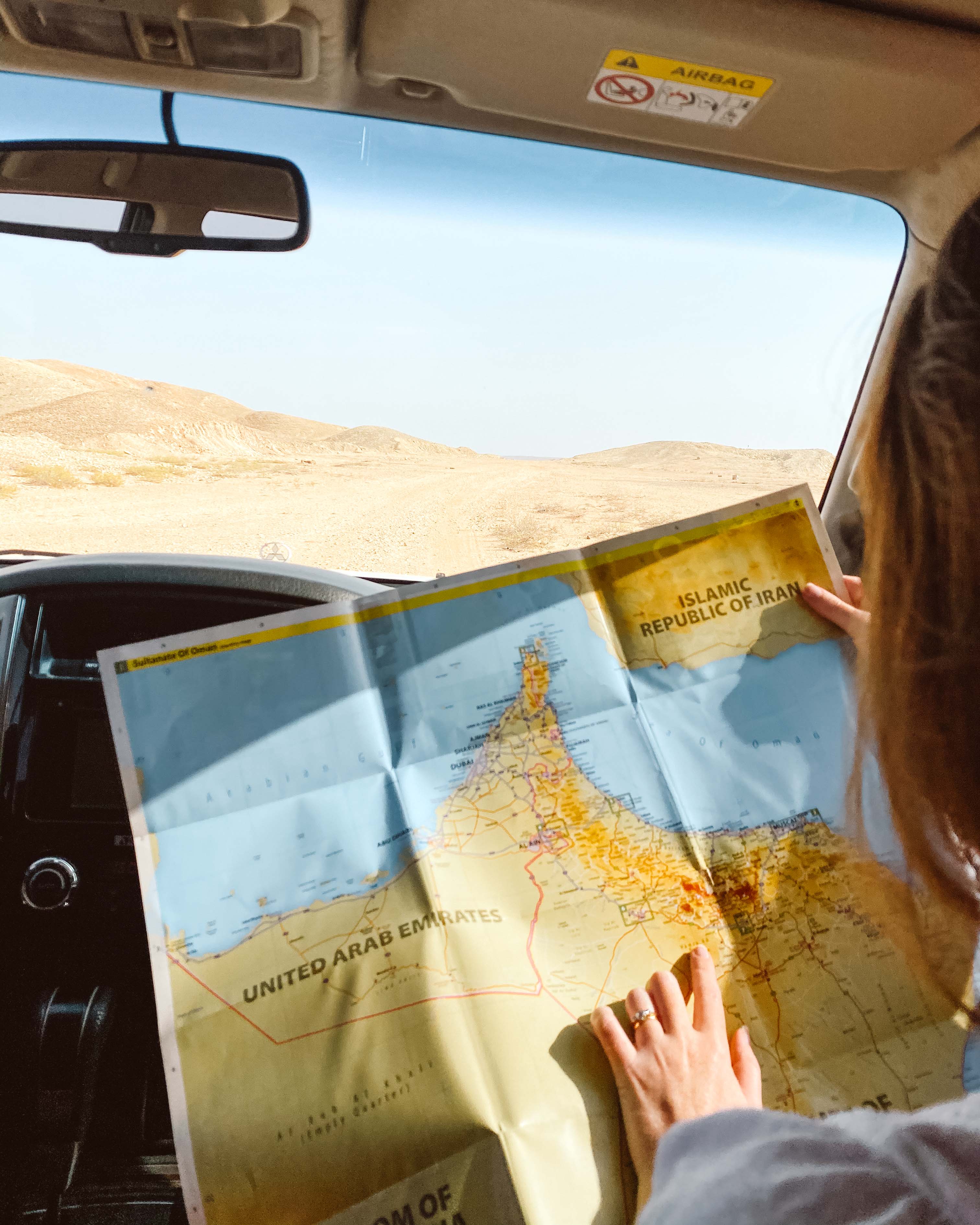
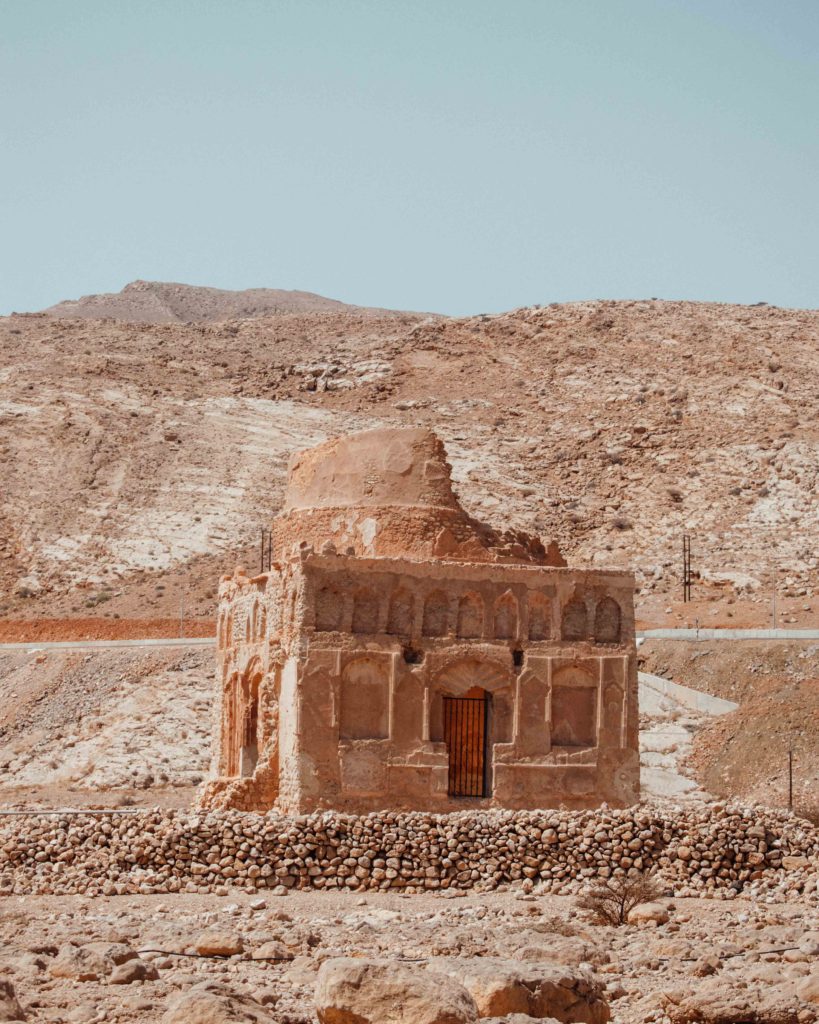
The site is small, but makes an interesting stop for a leg stretch on your way down to Sur. The 13thC Bibi Mariam’s Tomb is the main draw. Bibi Mariam was the wife of the Governor of Hormuz, Bahauddin Ayez, although reports vary about whether he built the tomb for her, or she built it herself. The tomb and the surrounding village of Qalhat were made a UNESCO Heritage Site in 2018.
Local visitors often light candles and leave offerings for Bahauddin and Mariam, even though this does not ordinarily play an important role in Ibadi Islam – the school followed by most Omanis.
SUR
The ancient fishing village of Sur tends to be an overnight stop for those making a longer trip on to Wahiba Sands, or coming down the coast from Muscat. It is the largest settlement along this stretch of coast, and therefore has the greatest choice of hotels and places to eat.
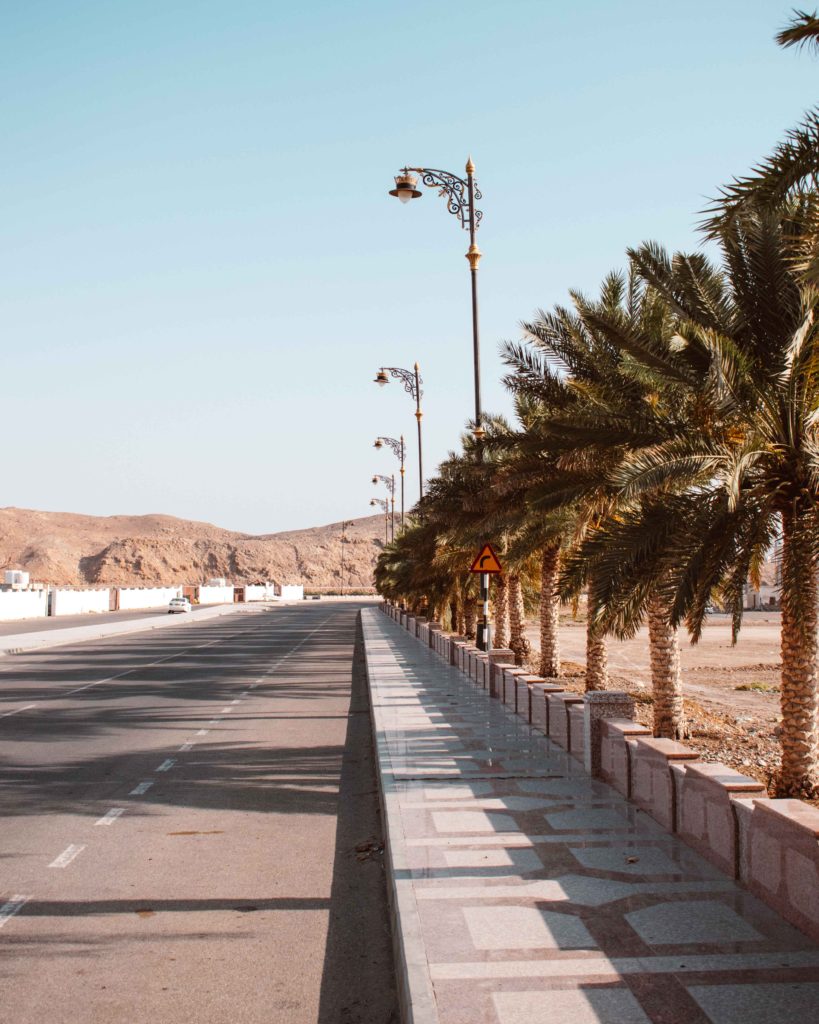
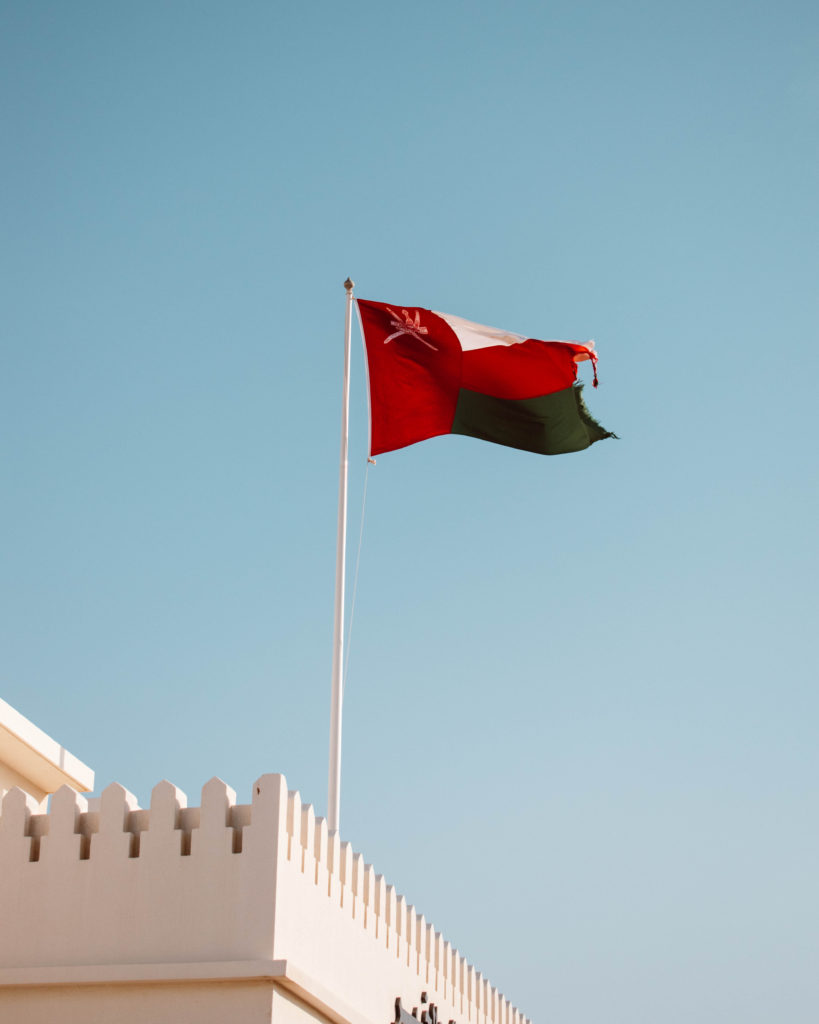
Dhow Building Yards – just south of the suspension bridge, is one of the last remaining dhow-building factories offering an opportunity to see how these traditional Arabian fishing boats are made. Dhows are built by eye from Indian and Burmese teak, with no plans. The factory produces two or three large dhows at any given time, and all are built to order. Today, most are destined for the tourism industry rather than maritime trading routes, although some have been commissioned by individuals. King Abdullah of Jordan had a dhow made here, along with other sheikhs and sultans in the region. There is a small souvenir shop on site.
Sur Lighthouse – located in the historical area of Ayjah, the raised terraces around the bottom of the lighthouse offer fantastic views back across the low rise skyline of Sur. The area around the lighthouse – Al Ayjah Old Town – is well worth exploring to get a sense of Sur’s history.
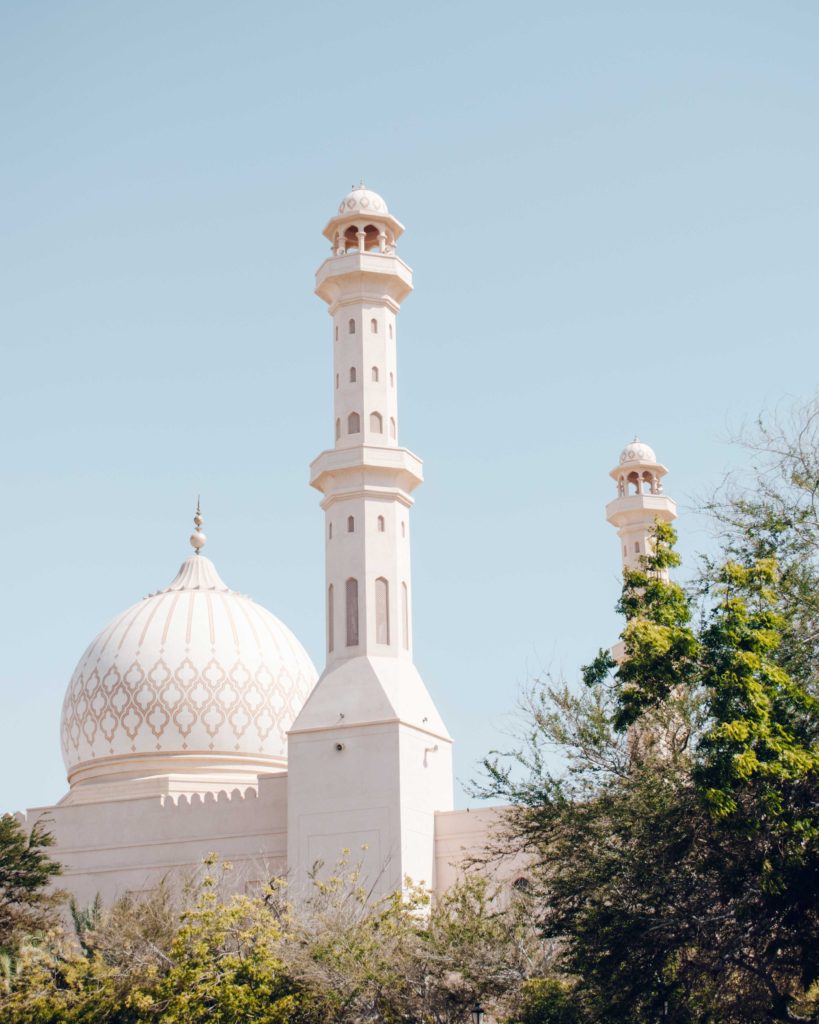
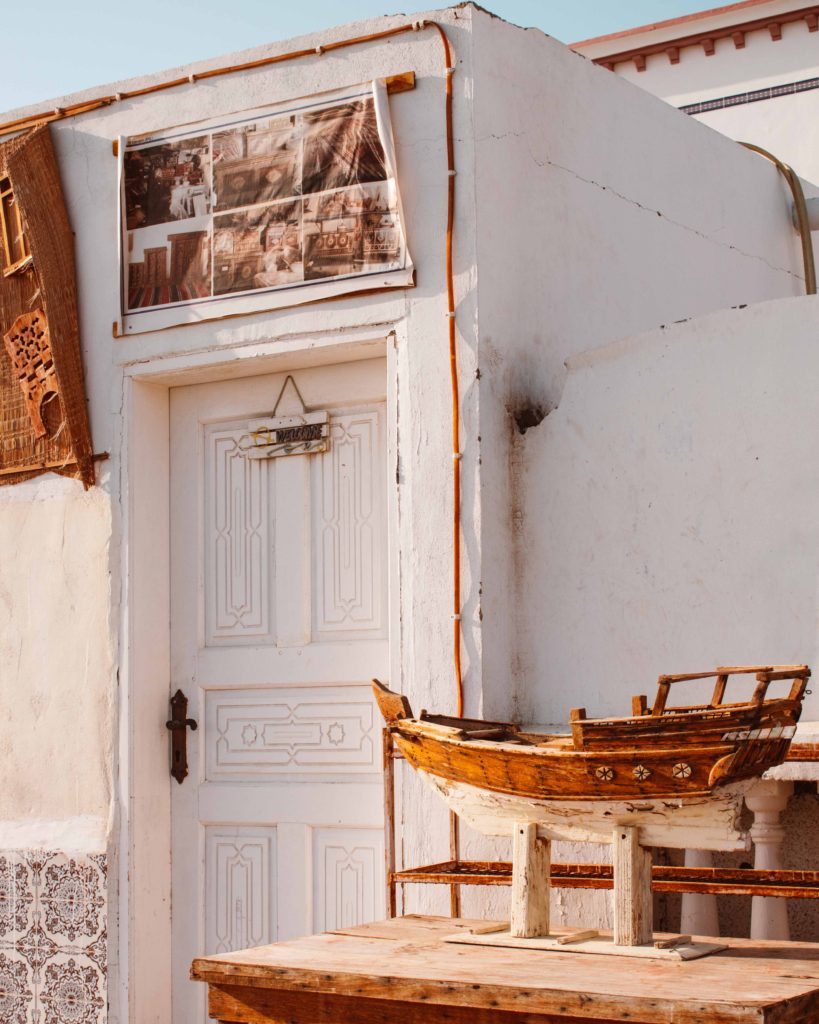
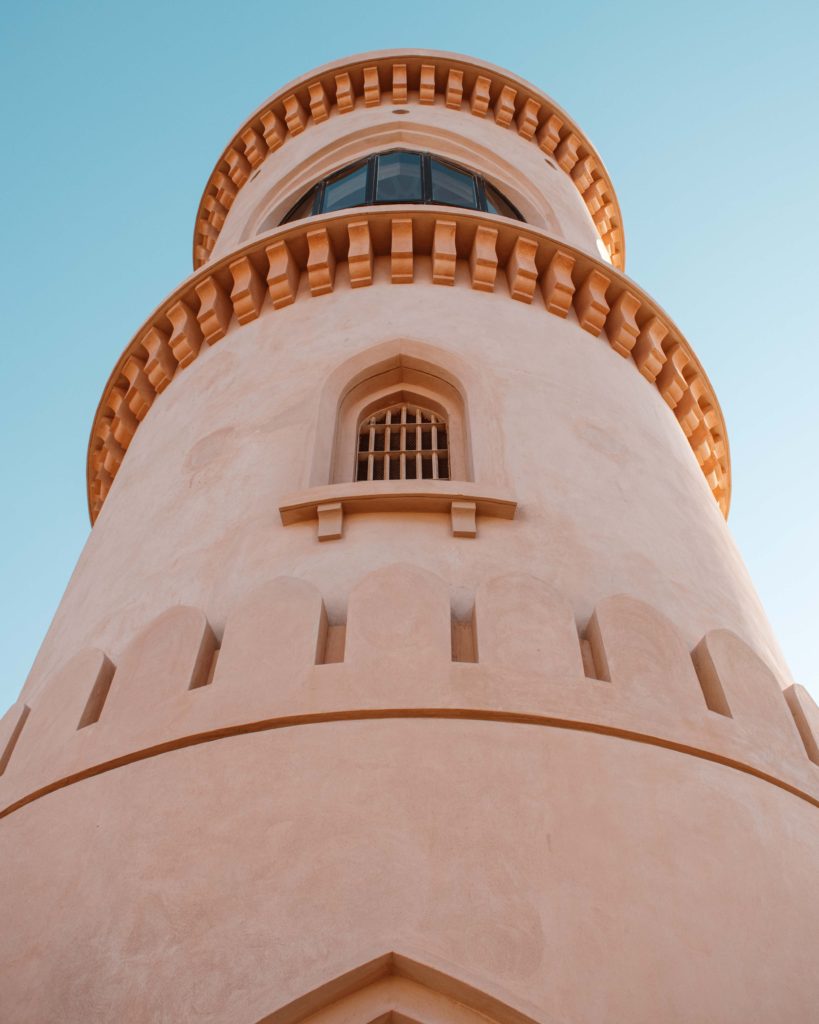
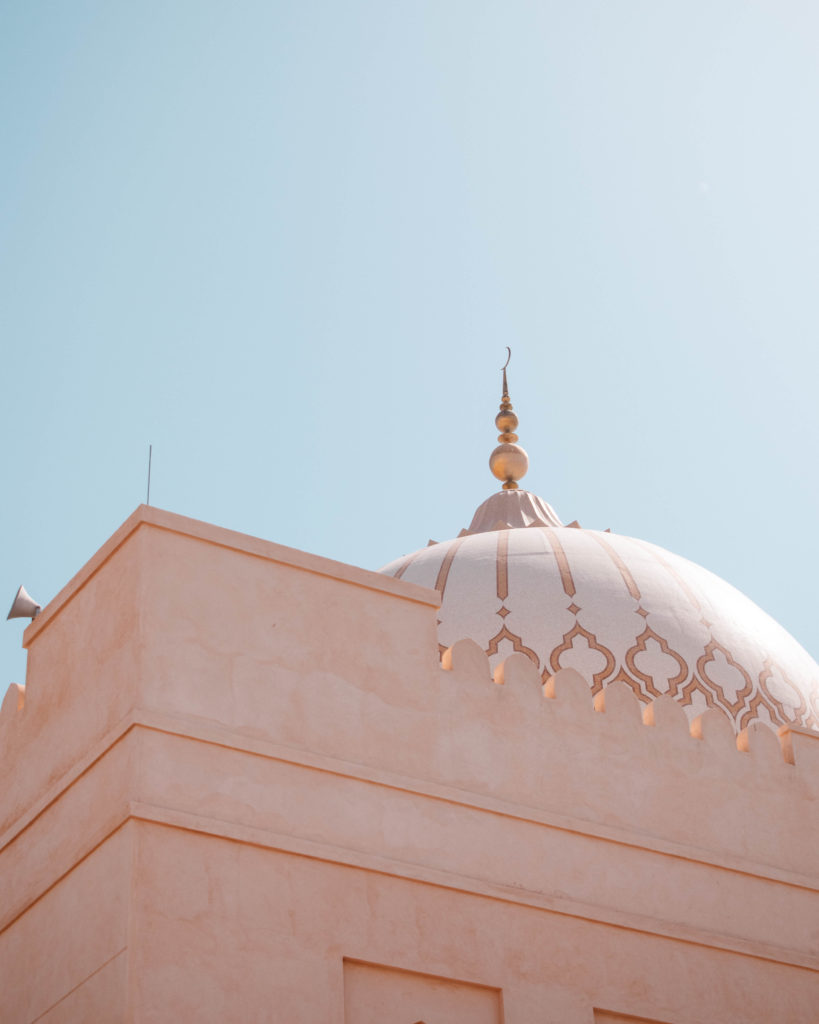
Al Ayjah Watchtower – for a birds eye view over the dhow building yards and Sur’s cream and white houses, climb up to the watch tower above the suspension bridge.
The Corniche – just like in Muscat, the Corniche of Sur is a lovely place for an evening walk.
Fatah Al Khair – beautifully restored dhow permanently mounted on dry land in an open air exhibition of Sur’s maritime history. The dhow was originally built in Sur in 1951.
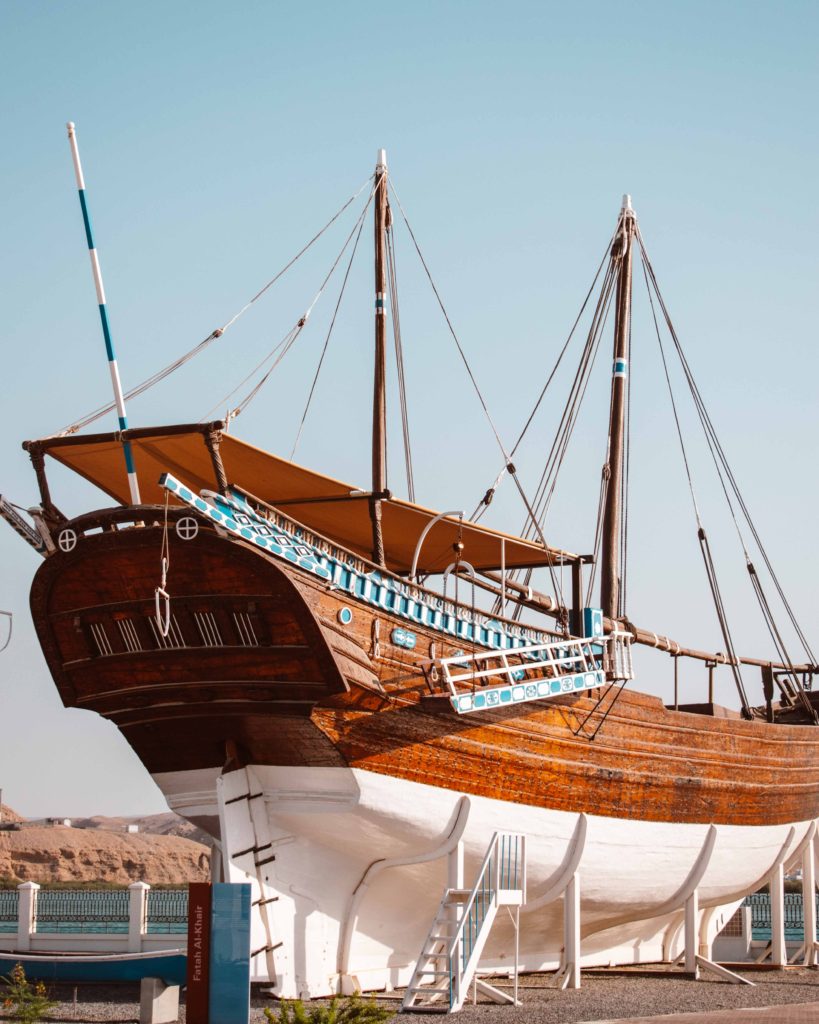
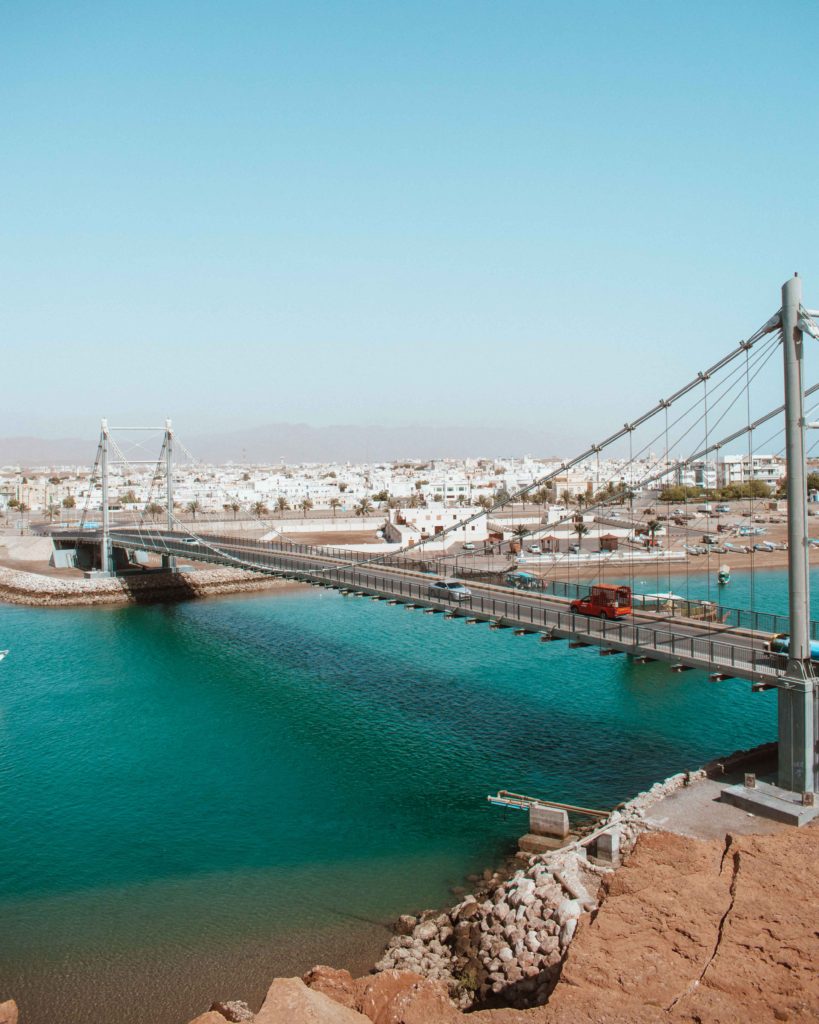
RAS AL HADD AND RAS AL JINZ
Around 45 mins further south from Sur is Ras Al Jinz. This small fishing village is one of the most important Green Turtle – an endangered species – nesting areas in the world, and this environment is essential to their survival. In 1996 the Omani government turned a 45km stretch along the coastline into a reserve, to protect the beach and the turtles.
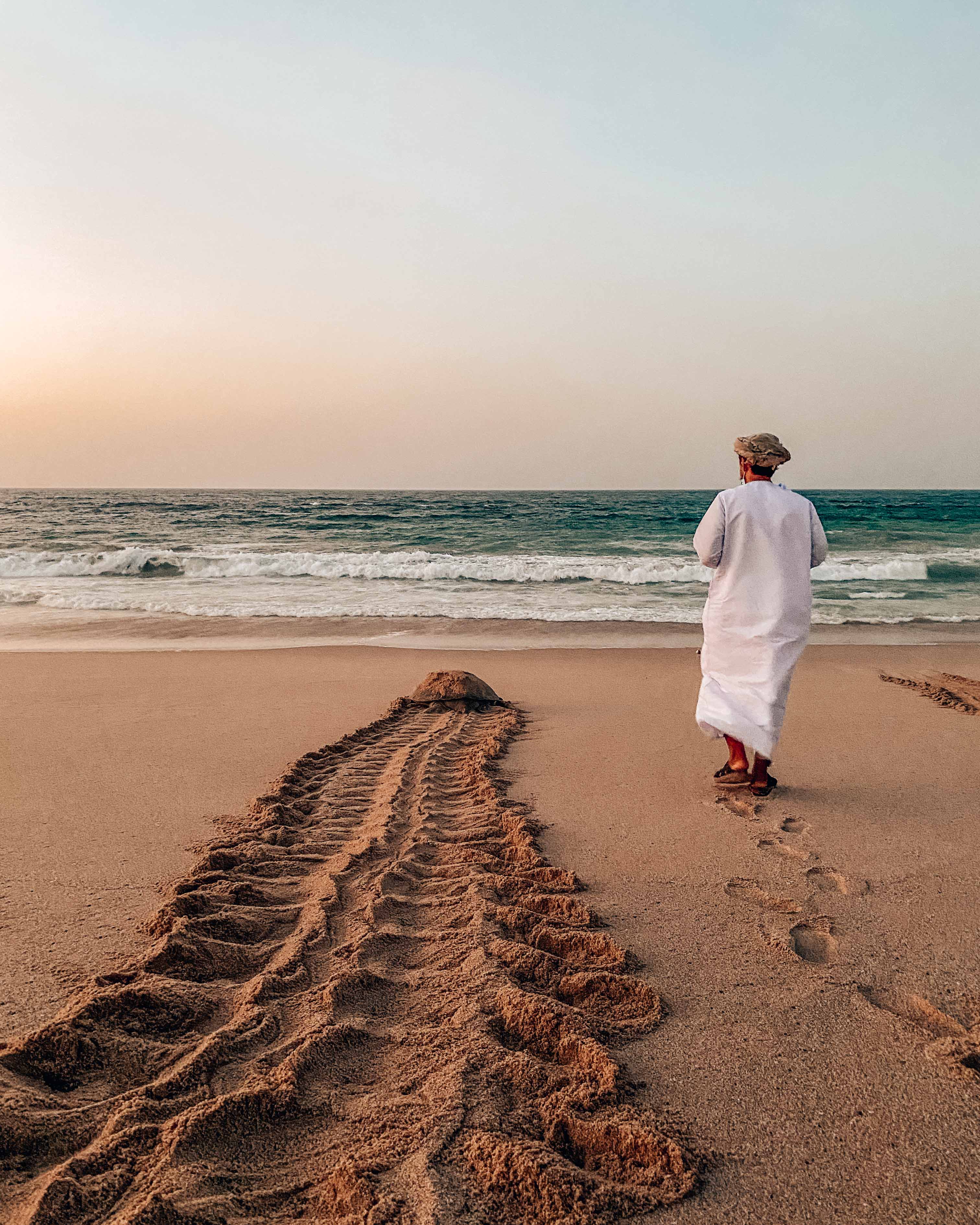
Turtles of Oman
Of the seven registered species of marine turtle, five are found in the waters of Oman: the Green, the Hawksbill, the Loggerhead, the Olive Ridley and the Leatherback. The Green Turtle are the most common, with an estimated 20,000 nesting each year along the Omani coastline.
Every two to four years, the females come ashore to lay their eggs – usually in two clutches on separate nights of around 100 eggs each. Each evening, turtles pull themselves up onto the sand to dig a hole to cover their eggs in, before returning to the sea. 55 days later the eggs will hatch, and the baby turtles start their dash across the sand and into the sea. Attrition is shocking – only around two or three out of every 10,000 will make it to adulthood.
Adults survive on sea grass and will travel distances of up to 3,000km in search of a meal. A fully grown turtle can be more than 1m in length, and weighs between 140-160kg.
The Ras Al Jinz Nature Reserve controls access to the beach, in order to protect this habit and ensure the turtles are able to continue nesting here. Tours are included in the room rate if you stay at the resort, or can be booked separately if you are staying elsewhere. For non-residents, tours are 8 OMR – although discounts are available for Omani citizens and residents of Oman.
Evening tours depart between 8.30pm and 9pm depending on the season, and the morning excursion heads to the beach between 4.30am and 5am. Tours are unsurprisingly popular, so I would recommend booking in advance. You are pretty much guaranteed to always see at least one or two turtles on any given tour, but peak nesting season is May – September.
When visiting the turtles be sure to stay a few metres behind them, and out of their eyeline. Keep noise to an absolute minimum and avoid using any lights which will disorient the hatchlings and scare the adults.
There is also a small museum at the Reserve, although I would recommend skipping it and instead reading up on the turtles online. The museum has a hefty 2 OMR entry price for very limited information.
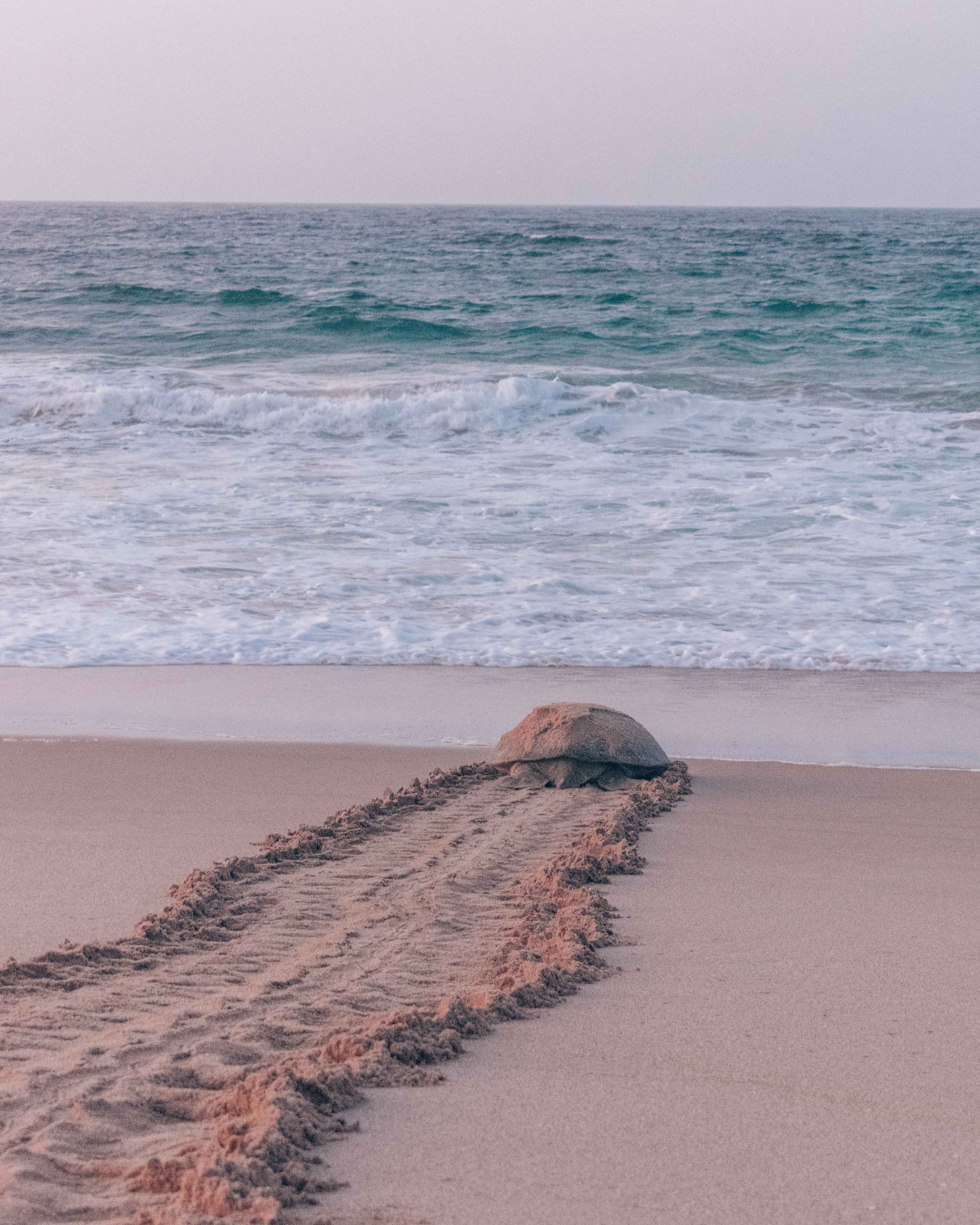
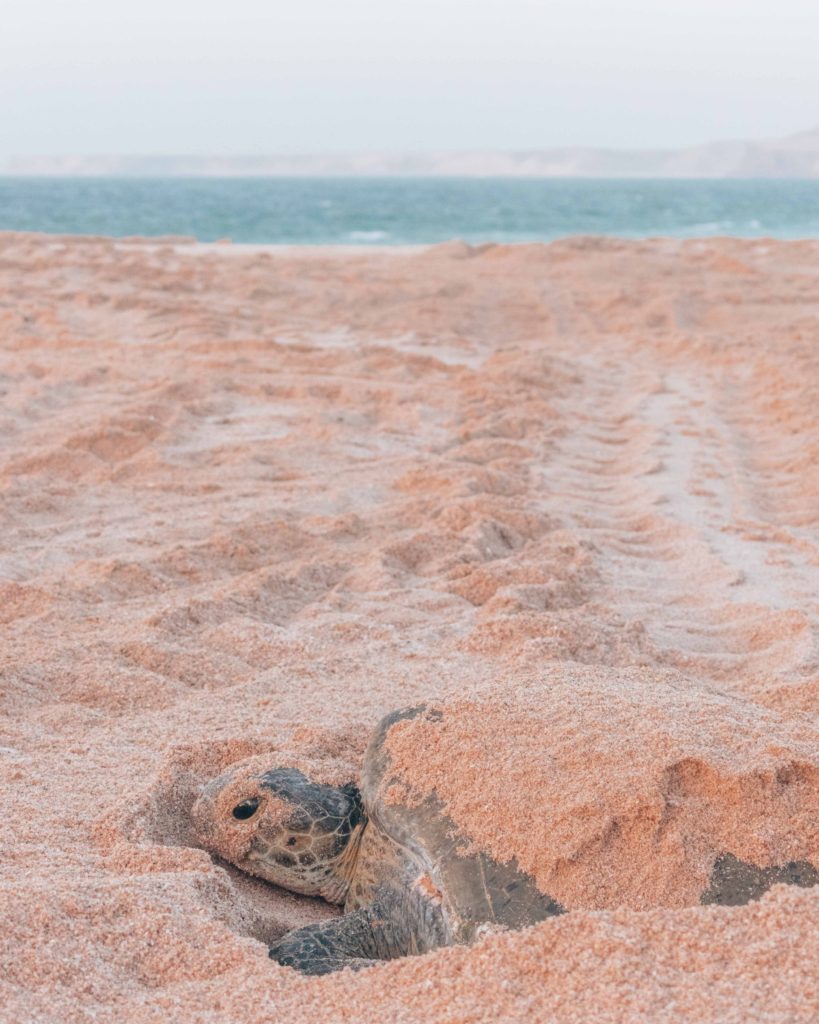
WHERE TO EAT
Zaki Restaurant – Indian, Chinese and Omani food in Sur. The grilled fish is delicious, and the restaurant fills with families in the evenings.
Sahari Restaurant – good mezze plates with wonderful views over the lagoon and toward the dhow building yards. Stick to the arabic offerings rather than the Chinese options on the menu.
Mersal Café and Lounge – bright café serving traditional Omani breakfasts in the centre of Sur.
Zahrat Bilad Al-Sham Restaurant – just off Hwy 23 in Sur, serving traditional Omani cuisine. Shawarma and kebab in casual surroundings.
WHERE TO SLEEP
Camp! – this stretch of coast is a popular weekend camping destination for Muscat’s residents in the cooler winter months. The cliffs around Fins are a particular weekend favourite for Oman’s residents.
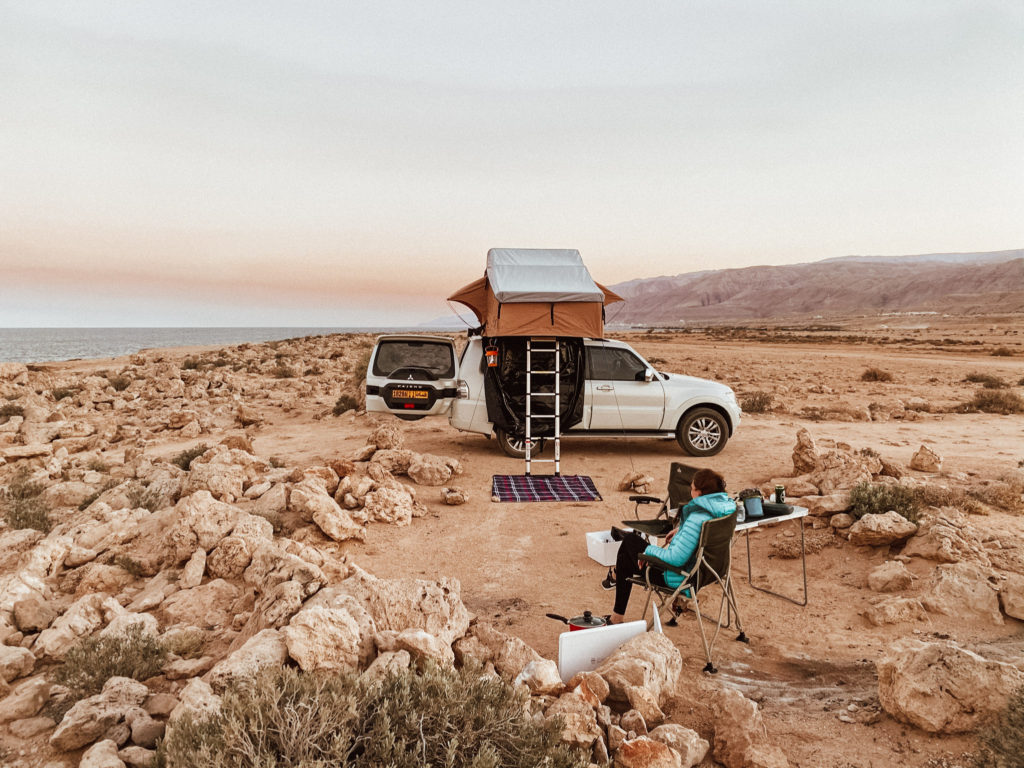
Wild camping in Oman is legal and a very popular weekend pastime. Just ensure you are considerate to local residents, and avoid camping near to any dwelling. It goes without saying that you should always follow the Leave No Trace principals – and ideally pick up any other rubbish you see when you leave. Sadly a number of beauty spots in Oman increasingly have a terrible litter problem, so taking away more than you came with is a wonderful way to help protect Oman’s natural environment. Likewise if camping near the beaches south of Sur, be mindful to check which areas are part of the protected reserve.
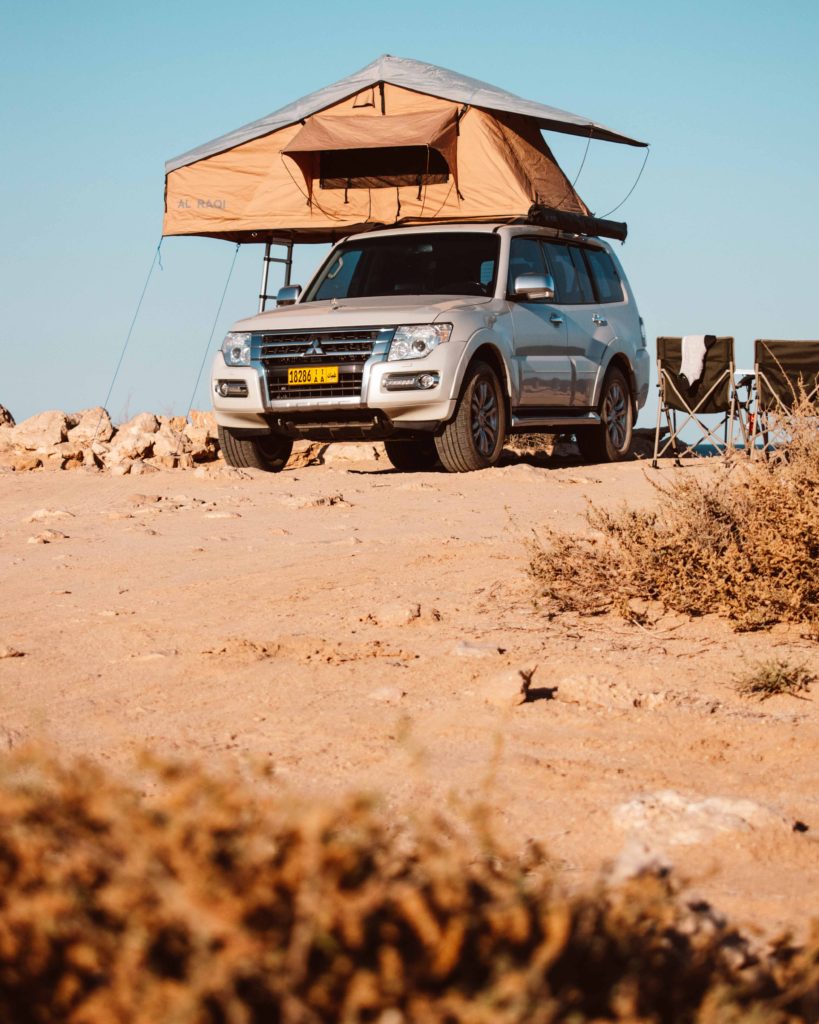
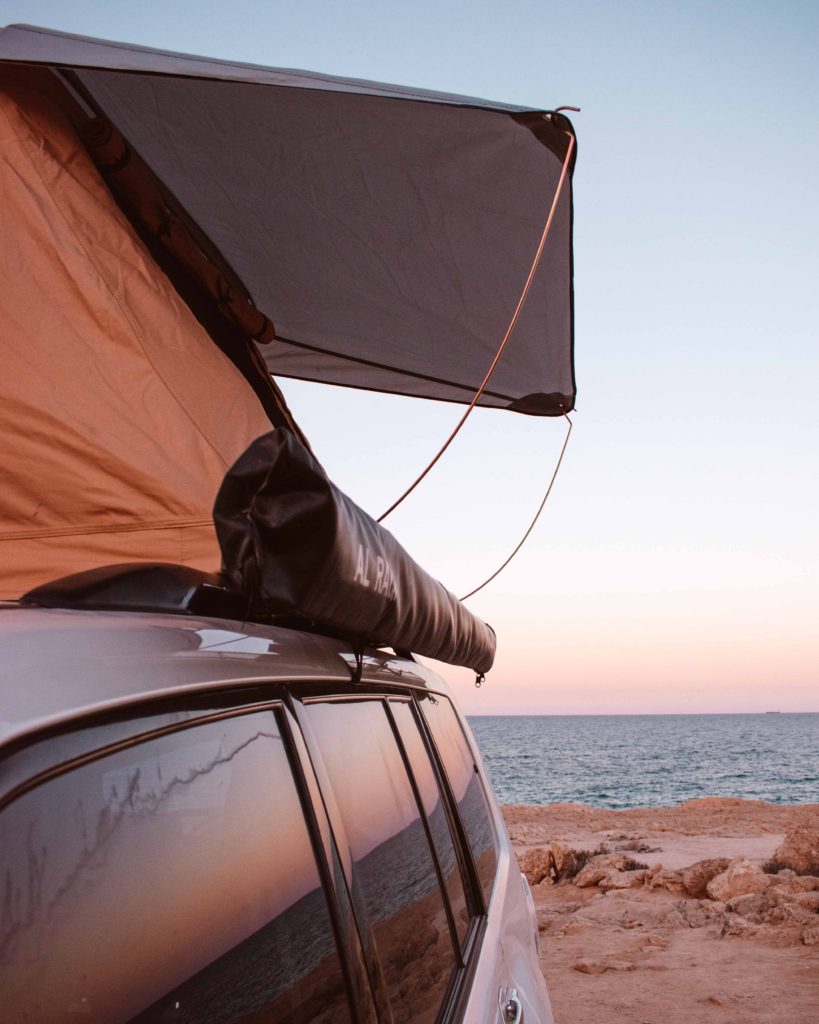
Half the fun of wild camping is setting out to find a camp spot, but if you want to find some places in advance I recommend checking out i-Overlander (iOS/Android). There are usually a few options marked, often with a short description and sometimes even a picture. The excellent Explorer Oman Off-Road book also marks suggested camping spots on all their routes. If you don’t buy this in advance of your trip (it can be crazily expensive online), you can get a copy in the WH Smiths in Muscat Airport or in one of the Borders Books in shopping malls around Muscat.
Sur Plaza Hotel – clean, comfortable rooms in a modern hotel with swimming pool. Licensed to serve alcohol.
Ras Al Jinz Reserve – permanent tents and hotel style rooms in the main building. The eco tents are air conditioned and well appointed with private bathrooms. Although the “sea facing” tents have a lovely view, they are located in a bit of a wind tunnel. If you are a light sleeper I would recommend asking for one the tents lower down. Tasty, but simple, breakfast buffet. Dinner (8 OMR) is not fantastic, so I would recommend taking a picnic to eat on the terrace of your tent instead.

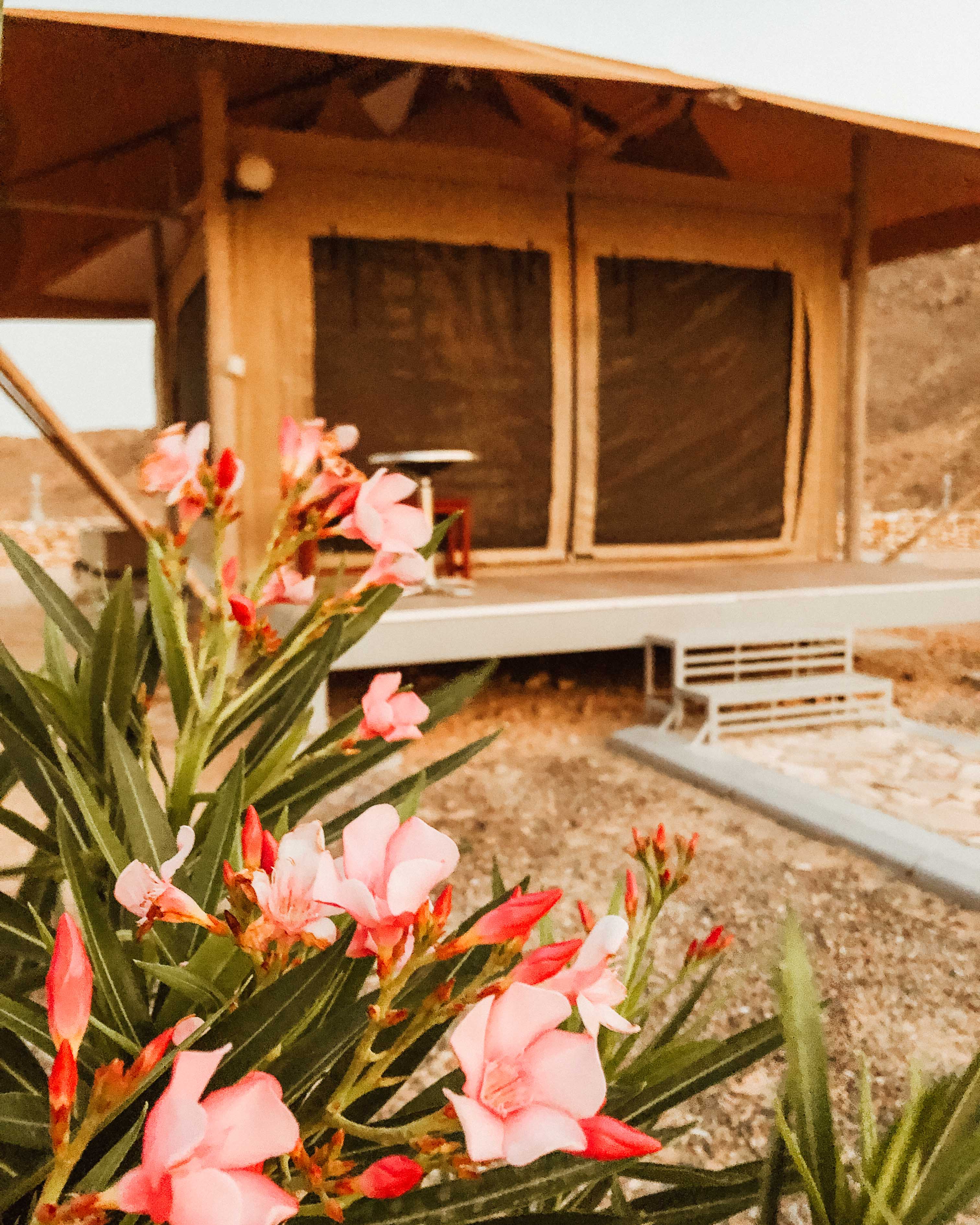
SAMA Ras Al Jinz Hotel – very short drive to the turtle reserve, with comfortable rooms. More affordable than the reserve, with a slightly higher standard of accommodation and food.
Wadi Shab Guest House – small friendly guest house just outside Tiwi. Simple, comfortable and clean rooms. Pay the few extra rials for the rooms with lovely sea views.
Don’t forget to check out my other guides to Oman if you are planning a visit. And if a trip to the Middle East isn’t on the cards for you for now, check out my other destination guides for inspiration for travels elsewhere.




Leave a Reply